Tourism's Impact and Future
VerifiedAdded on 2020/01/07
|16
|5643
|195
Essay
AI Summary
This assignment delves into the wide-ranging effects of tourism on societies and economies. It examines the positive contributions like economic growth and cultural exchange, as well as the potential negative consequences such as environmental degradation and cultural commodification. Students are tasked with analyzing research articles to understand the complex interplay between tourism development and sustainability. The focus is on evaluating current trends and predicting future challenges and opportunities within the tourism sector.
Contribute Materials
Your contribution can guide someone’s learning journey. Share your
documents today.

TRAVEL AND TOURISM
Secure Best Marks with AI Grader
Need help grading? Try our AI Grader for instant feedback on your assignments.
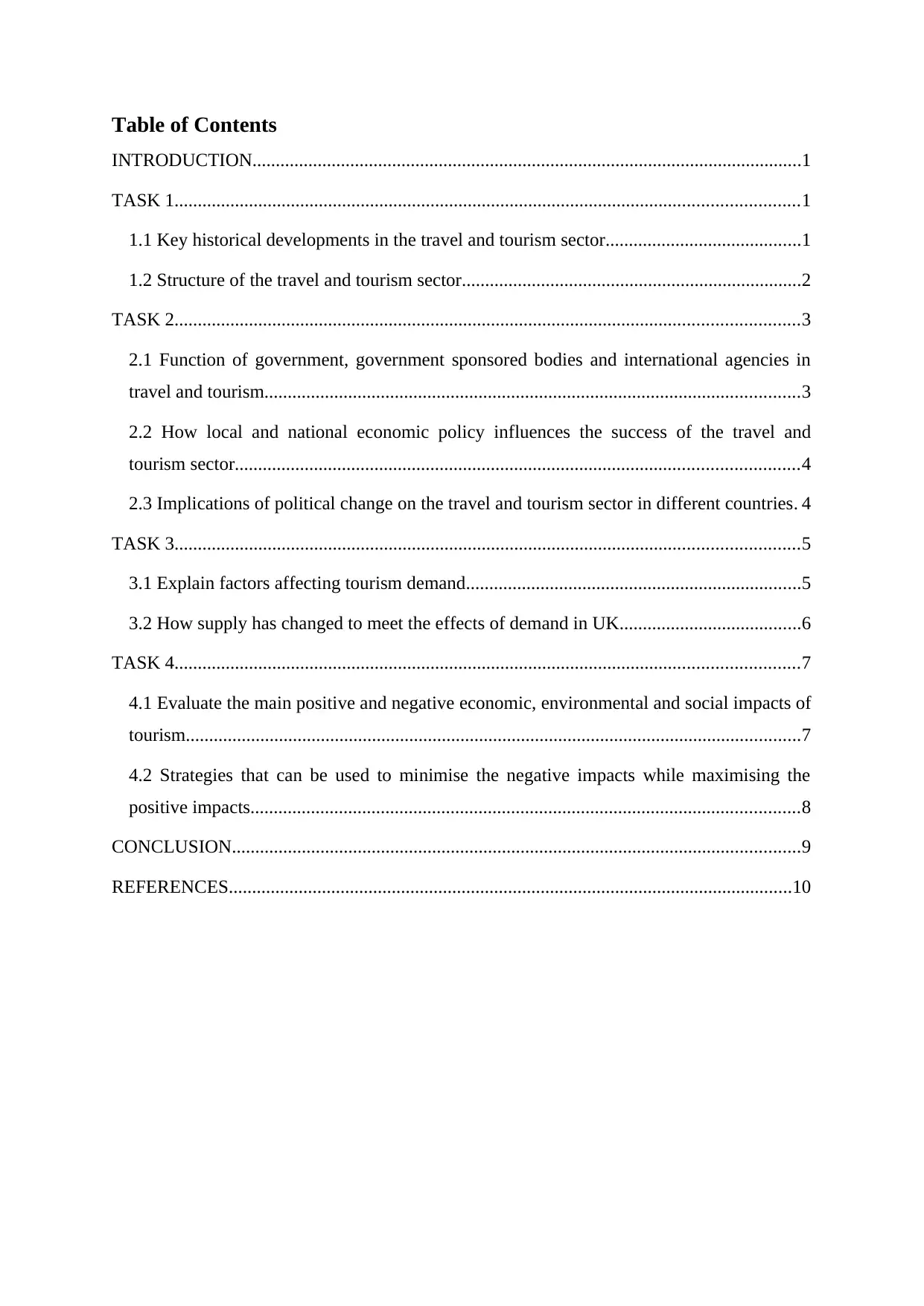
Table of Contents
INTRODUCTION......................................................................................................................1
TASK 1......................................................................................................................................1
1.1 Key historical developments in the travel and tourism sector..........................................1
1.2 Structure of the travel and tourism sector.........................................................................2
TASK 2......................................................................................................................................3
2.1 Function of government, government sponsored bodies and international agencies in
travel and tourism...................................................................................................................3
2.2 How local and national economic policy influences the success of the travel and
tourism sector.........................................................................................................................4
2.3 Implications of political change on the travel and tourism sector in different countries. 4
TASK 3......................................................................................................................................5
3.1 Explain factors affecting tourism demand........................................................................5
3.2 How supply has changed to meet the effects of demand in UK.......................................6
TASK 4......................................................................................................................................7
4.1 Evaluate the main positive and negative economic, environmental and social impacts of
tourism....................................................................................................................................7
4.2 Strategies that can be used to minimise the negative impacts while maximising the
positive impacts......................................................................................................................8
CONCLUSION..........................................................................................................................9
REFERENCES.........................................................................................................................10
INTRODUCTION......................................................................................................................1
TASK 1......................................................................................................................................1
1.1 Key historical developments in the travel and tourism sector..........................................1
1.2 Structure of the travel and tourism sector.........................................................................2
TASK 2......................................................................................................................................3
2.1 Function of government, government sponsored bodies and international agencies in
travel and tourism...................................................................................................................3
2.2 How local and national economic policy influences the success of the travel and
tourism sector.........................................................................................................................4
2.3 Implications of political change on the travel and tourism sector in different countries. 4
TASK 3......................................................................................................................................5
3.1 Explain factors affecting tourism demand........................................................................5
3.2 How supply has changed to meet the effects of demand in UK.......................................6
TASK 4......................................................................................................................................7
4.1 Evaluate the main positive and negative economic, environmental and social impacts of
tourism....................................................................................................................................7
4.2 Strategies that can be used to minimise the negative impacts while maximising the
positive impacts......................................................................................................................8
CONCLUSION..........................................................................................................................9
REFERENCES.........................................................................................................................10
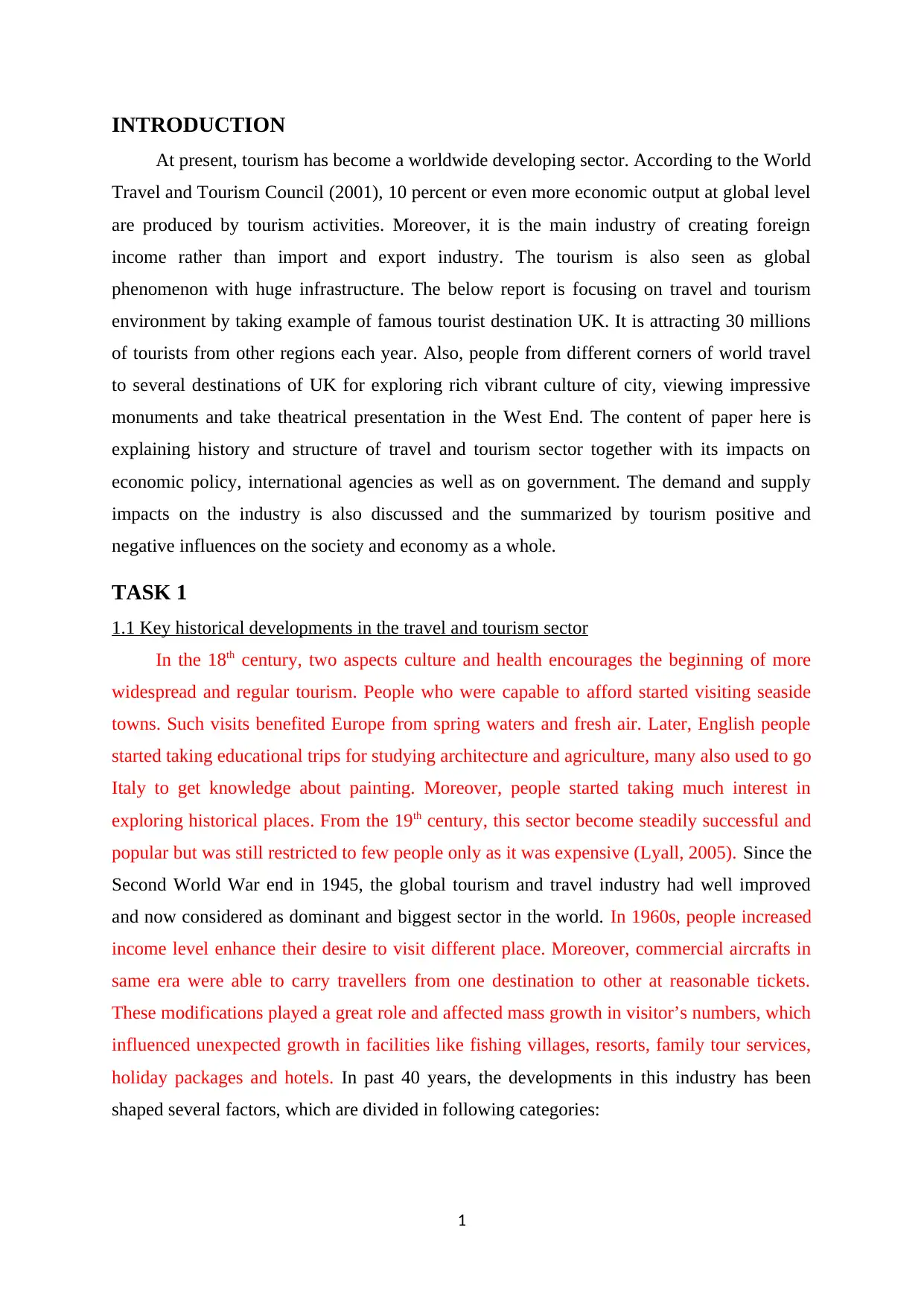
INTRODUCTION
At present, tourism has become a worldwide developing sector. According to the World
Travel and Tourism Council (2001), 10 percent or even more economic output at global level
are produced by tourism activities. Moreover, it is the main industry of creating foreign
income rather than import and export industry. The tourism is also seen as global
phenomenon with huge infrastructure. The below report is focusing on travel and tourism
environment by taking example of famous tourist destination UK. It is attracting 30 millions
of tourists from other regions each year. Also, people from different corners of world travel
to several destinations of UK for exploring rich vibrant culture of city, viewing impressive
monuments and take theatrical presentation in the West End. The content of paper here is
explaining history and structure of travel and tourism sector together with its impacts on
economic policy, international agencies as well as on government. The demand and supply
impacts on the industry is also discussed and the summarized by tourism positive and
negative influences on the society and economy as a whole.
TASK 1
1.1 Key historical developments in the travel and tourism sector
In the 18th century, two aspects culture and health encourages the beginning of more
widespread and regular tourism. People who were capable to afford started visiting seaside
towns. Such visits benefited Europe from spring waters and fresh air. Later, English people
started taking educational trips for studying architecture and agriculture, many also used to go
Italy to get knowledge about painting. Moreover, people started taking much interest in
exploring historical places. From the 19th century, this sector become steadily successful and
popular but was still restricted to few people only as it was expensive (Lyall, 2005). Since the
Second World War end in 1945, the global tourism and travel industry had well improved
and now considered as dominant and biggest sector in the world. In 1960s, people increased
income level enhance their desire to visit different place. Moreover, commercial aircrafts in
same era were able to carry travellers from one destination to other at reasonable tickets.
These modifications played a great role and affected mass growth in visitor’s numbers, which
influenced unexpected growth in facilities like fishing villages, resorts, family tour services,
holiday packages and hotels. In past 40 years, the developments in this industry has been
shaped several factors, which are divided in following categories:
1
At present, tourism has become a worldwide developing sector. According to the World
Travel and Tourism Council (2001), 10 percent or even more economic output at global level
are produced by tourism activities. Moreover, it is the main industry of creating foreign
income rather than import and export industry. The tourism is also seen as global
phenomenon with huge infrastructure. The below report is focusing on travel and tourism
environment by taking example of famous tourist destination UK. It is attracting 30 millions
of tourists from other regions each year. Also, people from different corners of world travel
to several destinations of UK for exploring rich vibrant culture of city, viewing impressive
monuments and take theatrical presentation in the West End. The content of paper here is
explaining history and structure of travel and tourism sector together with its impacts on
economic policy, international agencies as well as on government. The demand and supply
impacts on the industry is also discussed and the summarized by tourism positive and
negative influences on the society and economy as a whole.
TASK 1
1.1 Key historical developments in the travel and tourism sector
In the 18th century, two aspects culture and health encourages the beginning of more
widespread and regular tourism. People who were capable to afford started visiting seaside
towns. Such visits benefited Europe from spring waters and fresh air. Later, English people
started taking educational trips for studying architecture and agriculture, many also used to go
Italy to get knowledge about painting. Moreover, people started taking much interest in
exploring historical places. From the 19th century, this sector become steadily successful and
popular but was still restricted to few people only as it was expensive (Lyall, 2005). Since the
Second World War end in 1945, the global tourism and travel industry had well improved
and now considered as dominant and biggest sector in the world. In 1960s, people increased
income level enhance their desire to visit different place. Moreover, commercial aircrafts in
same era were able to carry travellers from one destination to other at reasonable tickets.
These modifications played a great role and affected mass growth in visitor’s numbers, which
influenced unexpected growth in facilities like fishing villages, resorts, family tour services,
holiday packages and hotels. In past 40 years, the developments in this industry has been
shaped several factors, which are divided in following categories:
1
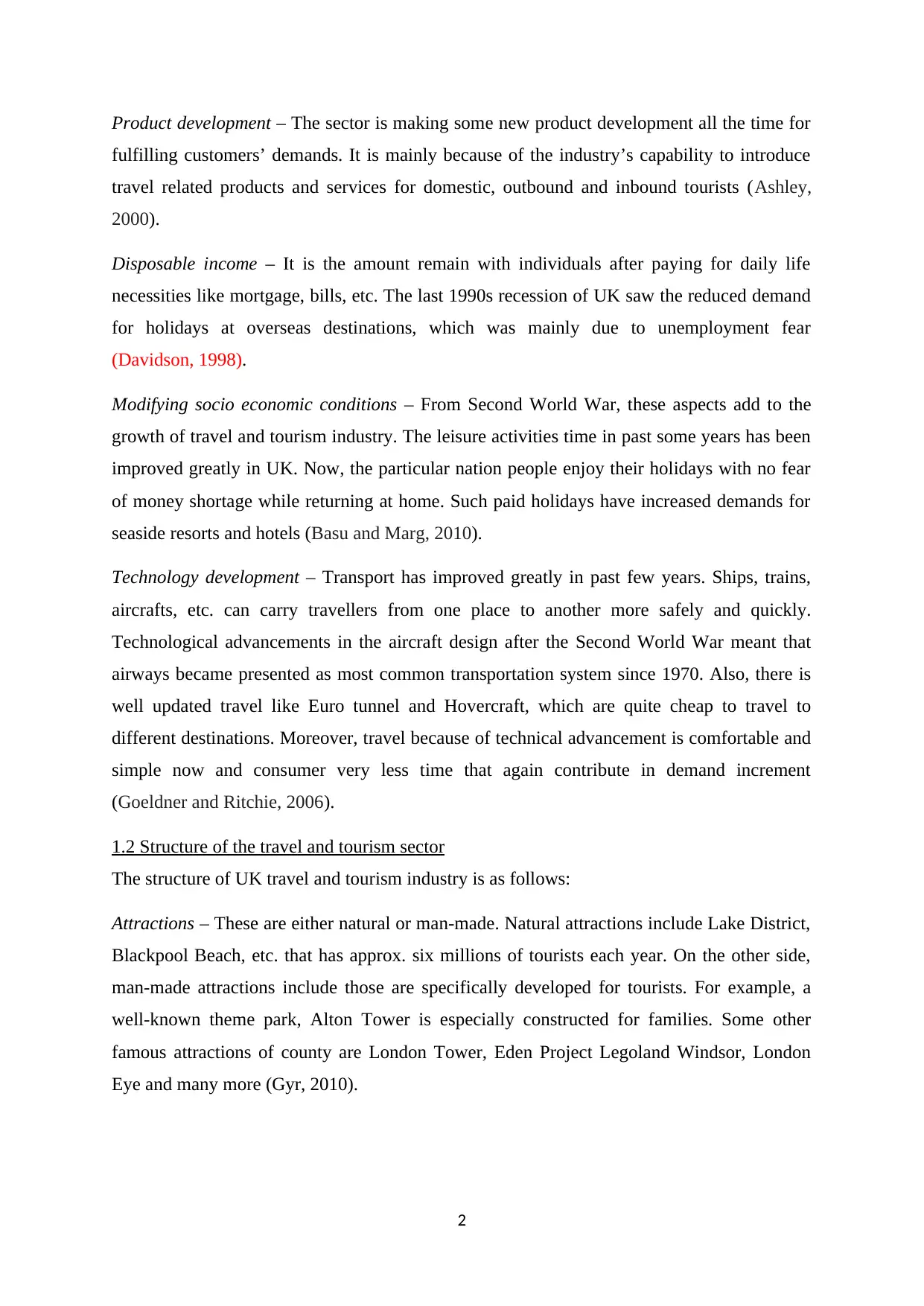
Product development – The sector is making some new product development all the time for
fulfilling customers’ demands. It is mainly because of the industry’s capability to introduce
travel related products and services for domestic, outbound and inbound tourists (Ashley,
2000).
Disposable income – It is the amount remain with individuals after paying for daily life
necessities like mortgage, bills, etc. The last 1990s recession of UK saw the reduced demand
for holidays at overseas destinations, which was mainly due to unemployment fear
(Davidson, 1998).
Modifying socio economic conditions – From Second World War, these aspects add to the
growth of travel and tourism industry. The leisure activities time in past some years has been
improved greatly in UK. Now, the particular nation people enjoy their holidays with no fear
of money shortage while returning at home. Such paid holidays have increased demands for
seaside resorts and hotels (Basu and Marg, 2010).
Technology development – Transport has improved greatly in past few years. Ships, trains,
aircrafts, etc. can carry travellers from one place to another more safely and quickly.
Technological advancements in the aircraft design after the Second World War meant that
airways became presented as most common transportation system since 1970. Also, there is
well updated travel like Euro tunnel and Hovercraft, which are quite cheap to travel to
different destinations. Moreover, travel because of technical advancement is comfortable and
simple now and consumer very less time that again contribute in demand increment
(Goeldner and Ritchie, 2006).
1.2 Structure of the travel and tourism sector
The structure of UK travel and tourism industry is as follows:
Attractions – These are either natural or man-made. Natural attractions include Lake District,
Blackpool Beach, etc. that has approx. six millions of tourists each year. On the other side,
man-made attractions include those are specifically developed for tourists. For example, a
well-known theme park, Alton Tower is especially constructed for families. Some other
famous attractions of county are London Tower, Eden Project Legoland Windsor, London
Eye and many more (Gyr, 2010).
2
fulfilling customers’ demands. It is mainly because of the industry’s capability to introduce
travel related products and services for domestic, outbound and inbound tourists (Ashley,
2000).
Disposable income – It is the amount remain with individuals after paying for daily life
necessities like mortgage, bills, etc. The last 1990s recession of UK saw the reduced demand
for holidays at overseas destinations, which was mainly due to unemployment fear
(Davidson, 1998).
Modifying socio economic conditions – From Second World War, these aspects add to the
growth of travel and tourism industry. The leisure activities time in past some years has been
improved greatly in UK. Now, the particular nation people enjoy their holidays with no fear
of money shortage while returning at home. Such paid holidays have increased demands for
seaside resorts and hotels (Basu and Marg, 2010).
Technology development – Transport has improved greatly in past few years. Ships, trains,
aircrafts, etc. can carry travellers from one place to another more safely and quickly.
Technological advancements in the aircraft design after the Second World War meant that
airways became presented as most common transportation system since 1970. Also, there is
well updated travel like Euro tunnel and Hovercraft, which are quite cheap to travel to
different destinations. Moreover, travel because of technical advancement is comfortable and
simple now and consumer very less time that again contribute in demand increment
(Goeldner and Ritchie, 2006).
1.2 Structure of the travel and tourism sector
The structure of UK travel and tourism industry is as follows:
Attractions – These are either natural or man-made. Natural attractions include Lake District,
Blackpool Beach, etc. that has approx. six millions of tourists each year. On the other side,
man-made attractions include those are specifically developed for tourists. For example, a
well-known theme park, Alton Tower is especially constructed for families. Some other
famous attractions of county are London Tower, Eden Project Legoland Windsor, London
Eye and many more (Gyr, 2010).
2
Secure Best Marks with AI Grader
Need help grading? Try our AI Grader for instant feedback on your assignments.
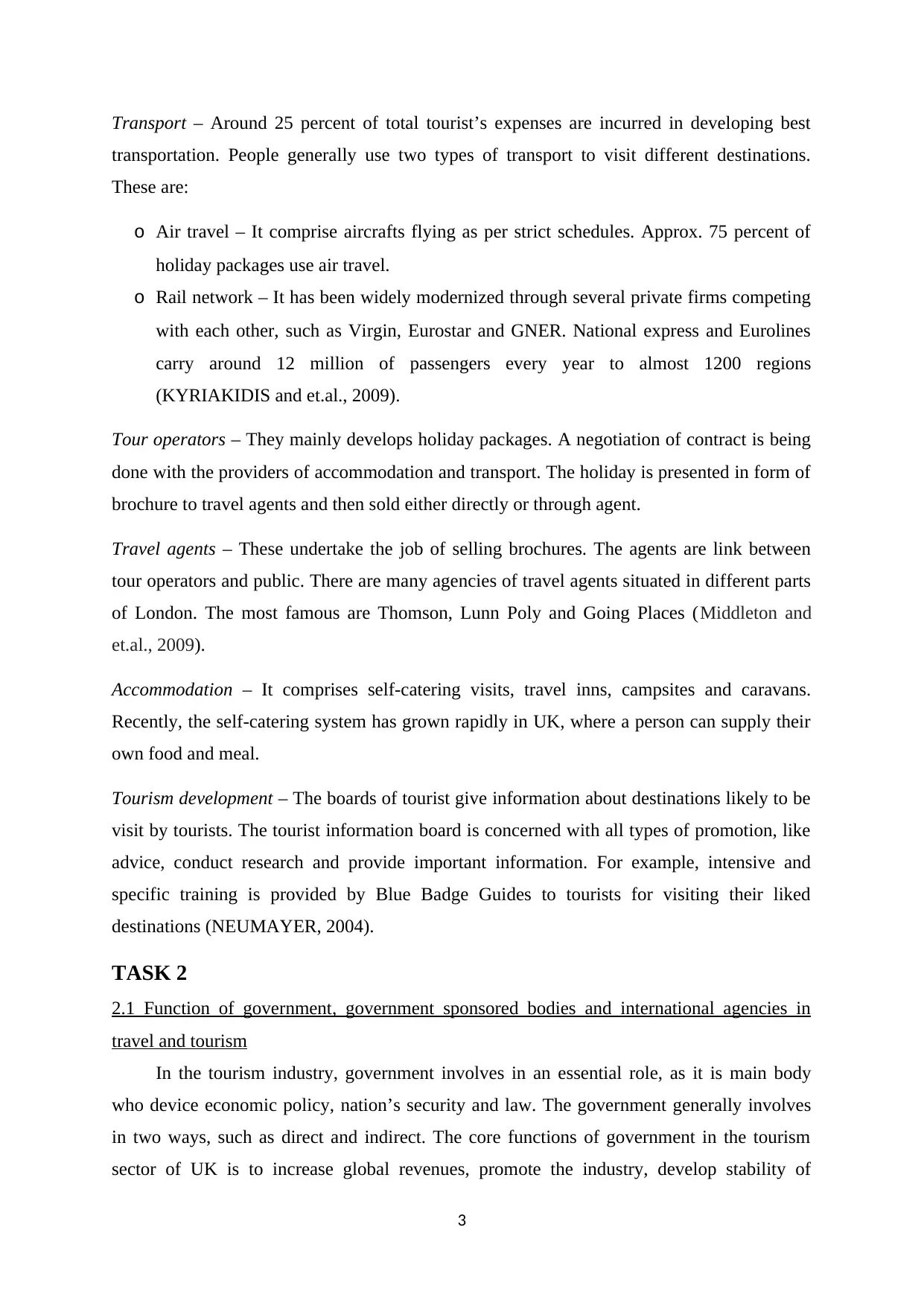
Transport – Around 25 percent of total tourist’s expenses are incurred in developing best
transportation. People generally use two types of transport to visit different destinations.
These are:
o Air travel – It comprise aircrafts flying as per strict schedules. Approx. 75 percent of
holiday packages use air travel.
o Rail network – It has been widely modernized through several private firms competing
with each other, such as Virgin, Eurostar and GNER. National express and Eurolines
carry around 12 million of passengers every year to almost 1200 regions
(KYRIAKIDIS and et.al., 2009).
Tour operators – They mainly develops holiday packages. A negotiation of contract is being
done with the providers of accommodation and transport. The holiday is presented in form of
brochure to travel agents and then sold either directly or through agent.
Travel agents – These undertake the job of selling brochures. The agents are link between
tour operators and public. There are many agencies of travel agents situated in different parts
of London. The most famous are Thomson, Lunn Poly and Going Places (Middleton and
et.al., 2009).
Accommodation – It comprises self-catering visits, travel inns, campsites and caravans.
Recently, the self-catering system has grown rapidly in UK, where a person can supply their
own food and meal.
Tourism development – The boards of tourist give information about destinations likely to be
visit by tourists. The tourist information board is concerned with all types of promotion, like
advice, conduct research and provide important information. For example, intensive and
specific training is provided by Blue Badge Guides to tourists for visiting their liked
destinations (NEUMAYER, 2004).
TASK 2
2.1 Function of government, government sponsored bodies and international agencies in
travel and tourism
In the tourism industry, government involves in an essential role, as it is main body
who device economic policy, nation’s security and law. The government generally involves
in two ways, such as direct and indirect. The core functions of government in the tourism
sector of UK is to increase global revenues, promote the industry, develop stability of
3
transportation. People generally use two types of transport to visit different destinations.
These are:
o Air travel – It comprise aircrafts flying as per strict schedules. Approx. 75 percent of
holiday packages use air travel.
o Rail network – It has been widely modernized through several private firms competing
with each other, such as Virgin, Eurostar and GNER. National express and Eurolines
carry around 12 million of passengers every year to almost 1200 regions
(KYRIAKIDIS and et.al., 2009).
Tour operators – They mainly develops holiday packages. A negotiation of contract is being
done with the providers of accommodation and transport. The holiday is presented in form of
brochure to travel agents and then sold either directly or through agent.
Travel agents – These undertake the job of selling brochures. The agents are link between
tour operators and public. There are many agencies of travel agents situated in different parts
of London. The most famous are Thomson, Lunn Poly and Going Places (Middleton and
et.al., 2009).
Accommodation – It comprises self-catering visits, travel inns, campsites and caravans.
Recently, the self-catering system has grown rapidly in UK, where a person can supply their
own food and meal.
Tourism development – The boards of tourist give information about destinations likely to be
visit by tourists. The tourist information board is concerned with all types of promotion, like
advice, conduct research and provide important information. For example, intensive and
specific training is provided by Blue Badge Guides to tourists for visiting their liked
destinations (NEUMAYER, 2004).
TASK 2
2.1 Function of government, government sponsored bodies and international agencies in
travel and tourism
In the tourism industry, government involves in an essential role, as it is main body
who device economic policy, nation’s security and law. The government generally involves
in two ways, such as direct and indirect. The core functions of government in the tourism
sector of UK is to increase global revenues, promote the industry, develop stability of
3
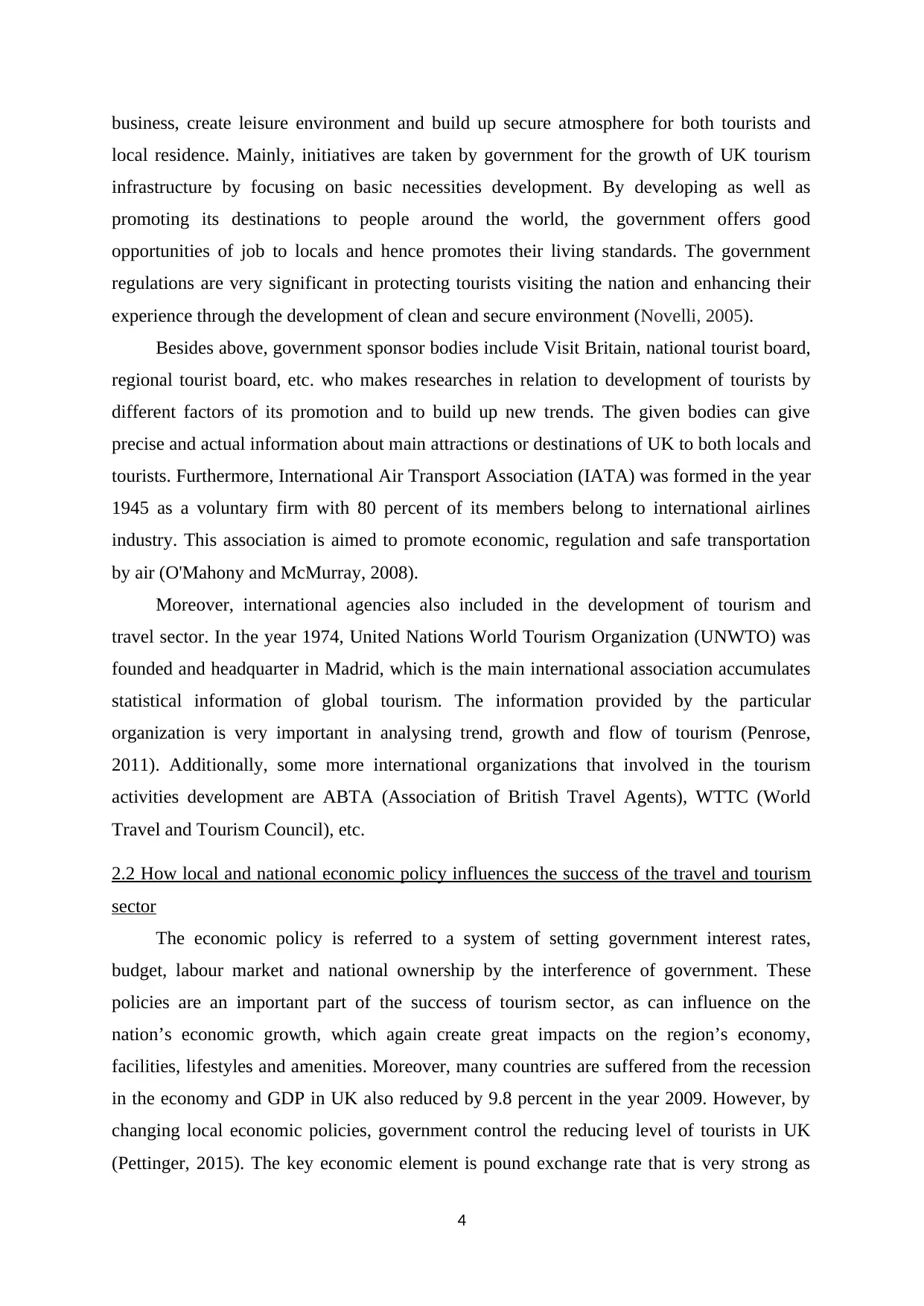
business, create leisure environment and build up secure atmosphere for both tourists and
local residence. Mainly, initiatives are taken by government for the growth of UK tourism
infrastructure by focusing on basic necessities development. By developing as well as
promoting its destinations to people around the world, the government offers good
opportunities of job to locals and hence promotes their living standards. The government
regulations are very significant in protecting tourists visiting the nation and enhancing their
experience through the development of clean and secure environment (Novelli, 2005).
Besides above, government sponsor bodies include Visit Britain, national tourist board,
regional tourist board, etc. who makes researches in relation to development of tourists by
different factors of its promotion and to build up new trends. The given bodies can give
precise and actual information about main attractions or destinations of UK to both locals and
tourists. Furthermore, International Air Transport Association (IATA) was formed in the year
1945 as a voluntary firm with 80 percent of its members belong to international airlines
industry. This association is aimed to promote economic, regulation and safe transportation
by air (O'Mahony and McMurray, 2008).
Moreover, international agencies also included in the development of tourism and
travel sector. In the year 1974, United Nations World Tourism Organization (UNWTO) was
founded and headquarter in Madrid, which is the main international association accumulates
statistical information of global tourism. The information provided by the particular
organization is very important in analysing trend, growth and flow of tourism (Penrose,
2011). Additionally, some more international organizations that involved in the tourism
activities development are ABTA (Association of British Travel Agents), WTTC (World
Travel and Tourism Council), etc.
2.2 How local and national economic policy influences the success of the travel and tourism
sector
The economic policy is referred to a system of setting government interest rates,
budget, labour market and national ownership by the interference of government. These
policies are an important part of the success of tourism sector, as can influence on the
nation’s economic growth, which again create great impacts on the region’s economy,
facilities, lifestyles and amenities. Moreover, many countries are suffered from the recession
in the economy and GDP in UK also reduced by 9.8 percent in the year 2009. However, by
changing local economic policies, government control the reducing level of tourists in UK
(Pettinger, 2015). The key economic element is pound exchange rate that is very strong as
4
local residence. Mainly, initiatives are taken by government for the growth of UK tourism
infrastructure by focusing on basic necessities development. By developing as well as
promoting its destinations to people around the world, the government offers good
opportunities of job to locals and hence promotes their living standards. The government
regulations are very significant in protecting tourists visiting the nation and enhancing their
experience through the development of clean and secure environment (Novelli, 2005).
Besides above, government sponsor bodies include Visit Britain, national tourist board,
regional tourist board, etc. who makes researches in relation to development of tourists by
different factors of its promotion and to build up new trends. The given bodies can give
precise and actual information about main attractions or destinations of UK to both locals and
tourists. Furthermore, International Air Transport Association (IATA) was formed in the year
1945 as a voluntary firm with 80 percent of its members belong to international airlines
industry. This association is aimed to promote economic, regulation and safe transportation
by air (O'Mahony and McMurray, 2008).
Moreover, international agencies also included in the development of tourism and
travel sector. In the year 1974, United Nations World Tourism Organization (UNWTO) was
founded and headquarter in Madrid, which is the main international association accumulates
statistical information of global tourism. The information provided by the particular
organization is very important in analysing trend, growth and flow of tourism (Penrose,
2011). Additionally, some more international organizations that involved in the tourism
activities development are ABTA (Association of British Travel Agents), WTTC (World
Travel and Tourism Council), etc.
2.2 How local and national economic policy influences the success of the travel and tourism
sector
The economic policy is referred to a system of setting government interest rates,
budget, labour market and national ownership by the interference of government. These
policies are an important part of the success of tourism sector, as can influence on the
nation’s economic growth, which again create great impacts on the region’s economy,
facilities, lifestyles and amenities. Moreover, many countries are suffered from the recession
in the economy and GDP in UK also reduced by 9.8 percent in the year 2009. However, by
changing local economic policies, government control the reducing level of tourists in UK
(Pettinger, 2015). The key economic element is pound exchange rate that is very strong as
4
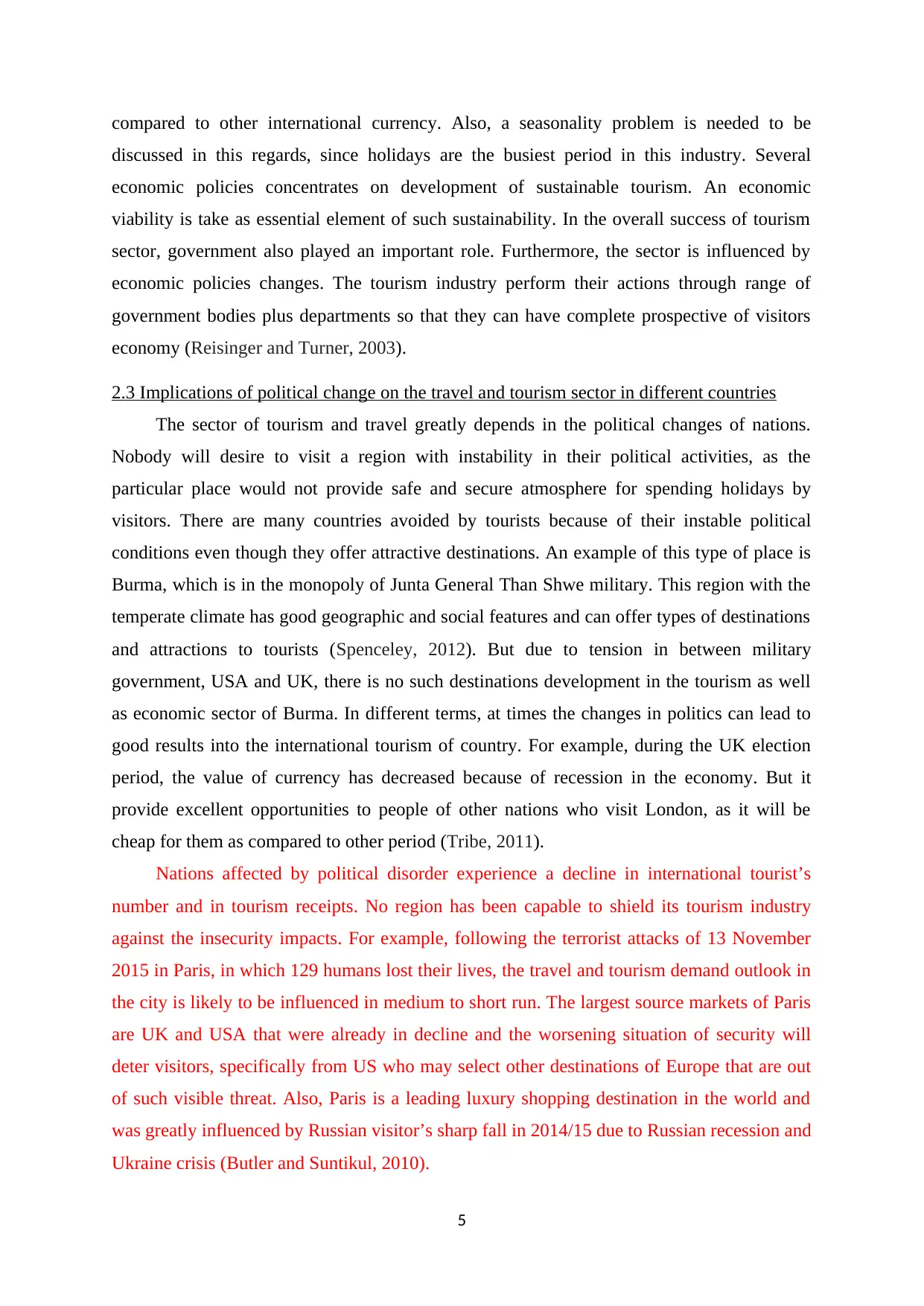
compared to other international currency. Also, a seasonality problem is needed to be
discussed in this regards, since holidays are the busiest period in this industry. Several
economic policies concentrates on development of sustainable tourism. An economic
viability is take as essential element of such sustainability. In the overall success of tourism
sector, government also played an important role. Furthermore, the sector is influenced by
economic policies changes. The tourism industry perform their actions through range of
government bodies plus departments so that they can have complete prospective of visitors
economy (Reisinger and Turner, 2003).
2.3 Implications of political change on the travel and tourism sector in different countries
The sector of tourism and travel greatly depends in the political changes of nations.
Nobody will desire to visit a region with instability in their political activities, as the
particular place would not provide safe and secure atmosphere for spending holidays by
visitors. There are many countries avoided by tourists because of their instable political
conditions even though they offer attractive destinations. An example of this type of place is
Burma, which is in the monopoly of Junta General Than Shwe military. This region with the
temperate climate has good geographic and social features and can offer types of destinations
and attractions to tourists (Spenceley, 2012). But due to tension in between military
government, USA and UK, there is no such destinations development in the tourism as well
as economic sector of Burma. In different terms, at times the changes in politics can lead to
good results into the international tourism of country. For example, during the UK election
period, the value of currency has decreased because of recession in the economy. But it
provide excellent opportunities to people of other nations who visit London, as it will be
cheap for them as compared to other period (Tribe, 2011).
Nations affected by political disorder experience a decline in international tourist’s
number and in tourism receipts. No region has been capable to shield its tourism industry
against the insecurity impacts. For example, following the terrorist attacks of 13 November
2015 in Paris, in which 129 humans lost their lives, the travel and tourism demand outlook in
the city is likely to be influenced in medium to short run. The largest source markets of Paris
are UK and USA that were already in decline and the worsening situation of security will
deter visitors, specifically from US who may select other destinations of Europe that are out
of such visible threat. Also, Paris is a leading luxury shopping destination in the world and
was greatly influenced by Russian visitor’s sharp fall in 2014/15 due to Russian recession and
Ukraine crisis (Butler and Suntikul, 2010).
5
discussed in this regards, since holidays are the busiest period in this industry. Several
economic policies concentrates on development of sustainable tourism. An economic
viability is take as essential element of such sustainability. In the overall success of tourism
sector, government also played an important role. Furthermore, the sector is influenced by
economic policies changes. The tourism industry perform their actions through range of
government bodies plus departments so that they can have complete prospective of visitors
economy (Reisinger and Turner, 2003).
2.3 Implications of political change on the travel and tourism sector in different countries
The sector of tourism and travel greatly depends in the political changes of nations.
Nobody will desire to visit a region with instability in their political activities, as the
particular place would not provide safe and secure atmosphere for spending holidays by
visitors. There are many countries avoided by tourists because of their instable political
conditions even though they offer attractive destinations. An example of this type of place is
Burma, which is in the monopoly of Junta General Than Shwe military. This region with the
temperate climate has good geographic and social features and can offer types of destinations
and attractions to tourists (Spenceley, 2012). But due to tension in between military
government, USA and UK, there is no such destinations development in the tourism as well
as economic sector of Burma. In different terms, at times the changes in politics can lead to
good results into the international tourism of country. For example, during the UK election
period, the value of currency has decreased because of recession in the economy. But it
provide excellent opportunities to people of other nations who visit London, as it will be
cheap for them as compared to other period (Tribe, 2011).
Nations affected by political disorder experience a decline in international tourist’s
number and in tourism receipts. No region has been capable to shield its tourism industry
against the insecurity impacts. For example, following the terrorist attacks of 13 November
2015 in Paris, in which 129 humans lost their lives, the travel and tourism demand outlook in
the city is likely to be influenced in medium to short run. The largest source markets of Paris
are UK and USA that were already in decline and the worsening situation of security will
deter visitors, specifically from US who may select other destinations of Europe that are out
of such visible threat. Also, Paris is a leading luxury shopping destination in the world and
was greatly influenced by Russian visitor’s sharp fall in 2014/15 due to Russian recession and
Ukraine crisis (Butler and Suntikul, 2010).
5
Paraphrase This Document
Need a fresh take? Get an instant paraphrase of this document with our AI Paraphraser
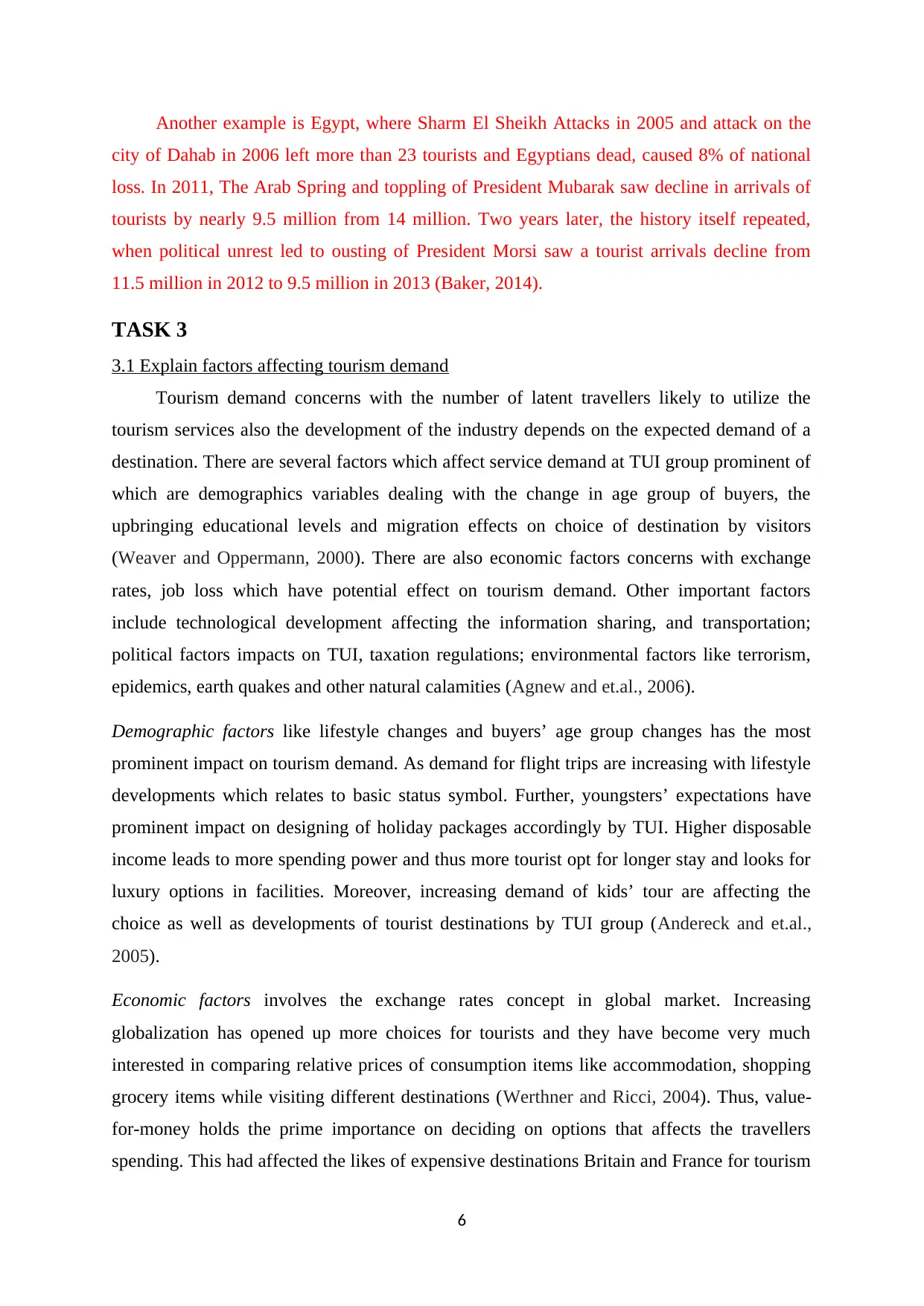
Another example is Egypt, where Sharm El Sheikh Attacks in 2005 and attack on the
city of Dahab in 2006 left more than 23 tourists and Egyptians dead, caused 8% of national
loss. In 2011, The Arab Spring and toppling of President Mubarak saw decline in arrivals of
tourists by nearly 9.5 million from 14 million. Two years later, the history itself repeated,
when political unrest led to ousting of President Morsi saw a tourist arrivals decline from
11.5 million in 2012 to 9.5 million in 2013 (Baker, 2014).
TASK 3
3.1 Explain factors affecting tourism demand
Tourism demand concerns with the number of latent travellers likely to utilize the
tourism services also the development of the industry depends on the expected demand of a
destination. There are several factors which affect service demand at TUI group prominent of
which are demographics variables dealing with the change in age group of buyers, the
upbringing educational levels and migration effects on choice of destination by visitors
(Weaver and Oppermann, 2000). There are also economic factors concerns with exchange
rates, job loss which have potential effect on tourism demand. Other important factors
include technological development affecting the information sharing, and transportation;
political factors impacts on TUI, taxation regulations; environmental factors like terrorism,
epidemics, earth quakes and other natural calamities (Agnew and et.al., 2006).
Demographic factors like lifestyle changes and buyers’ age group changes has the most
prominent impact on tourism demand. As demand for flight trips are increasing with lifestyle
developments which relates to basic status symbol. Further, youngsters’ expectations have
prominent impact on designing of holiday packages accordingly by TUI. Higher disposable
income leads to more spending power and thus more tourist opt for longer stay and looks for
luxury options in facilities. Moreover, increasing demand of kids’ tour are affecting the
choice as well as developments of tourist destinations by TUI group (Andereck and et.al.,
2005).
Economic factors involves the exchange rates concept in global market. Increasing
globalization has opened up more choices for tourists and they have become very much
interested in comparing relative prices of consumption items like accommodation, shopping
grocery items while visiting different destinations (Werthner and Ricci, 2004). Thus, value-
for-money holds the prime importance on deciding on options that affects the travellers
spending. This had affected the likes of expensive destinations Britain and France for tourism
6
city of Dahab in 2006 left more than 23 tourists and Egyptians dead, caused 8% of national
loss. In 2011, The Arab Spring and toppling of President Mubarak saw decline in arrivals of
tourists by nearly 9.5 million from 14 million. Two years later, the history itself repeated,
when political unrest led to ousting of President Morsi saw a tourist arrivals decline from
11.5 million in 2012 to 9.5 million in 2013 (Baker, 2014).
TASK 3
3.1 Explain factors affecting tourism demand
Tourism demand concerns with the number of latent travellers likely to utilize the
tourism services also the development of the industry depends on the expected demand of a
destination. There are several factors which affect service demand at TUI group prominent of
which are demographics variables dealing with the change in age group of buyers, the
upbringing educational levels and migration effects on choice of destination by visitors
(Weaver and Oppermann, 2000). There are also economic factors concerns with exchange
rates, job loss which have potential effect on tourism demand. Other important factors
include technological development affecting the information sharing, and transportation;
political factors impacts on TUI, taxation regulations; environmental factors like terrorism,
epidemics, earth quakes and other natural calamities (Agnew and et.al., 2006).
Demographic factors like lifestyle changes and buyers’ age group changes has the most
prominent impact on tourism demand. As demand for flight trips are increasing with lifestyle
developments which relates to basic status symbol. Further, youngsters’ expectations have
prominent impact on designing of holiday packages accordingly by TUI. Higher disposable
income leads to more spending power and thus more tourist opt for longer stay and looks for
luxury options in facilities. Moreover, increasing demand of kids’ tour are affecting the
choice as well as developments of tourist destinations by TUI group (Andereck and et.al.,
2005).
Economic factors involves the exchange rates concept in global market. Increasing
globalization has opened up more choices for tourists and they have become very much
interested in comparing relative prices of consumption items like accommodation, shopping
grocery items while visiting different destinations (Werthner and Ricci, 2004). Thus, value-
for-money holds the prime importance on deciding on options that affects the travellers
spending. This had affected the likes of expensive destinations Britain and France for tourism
6
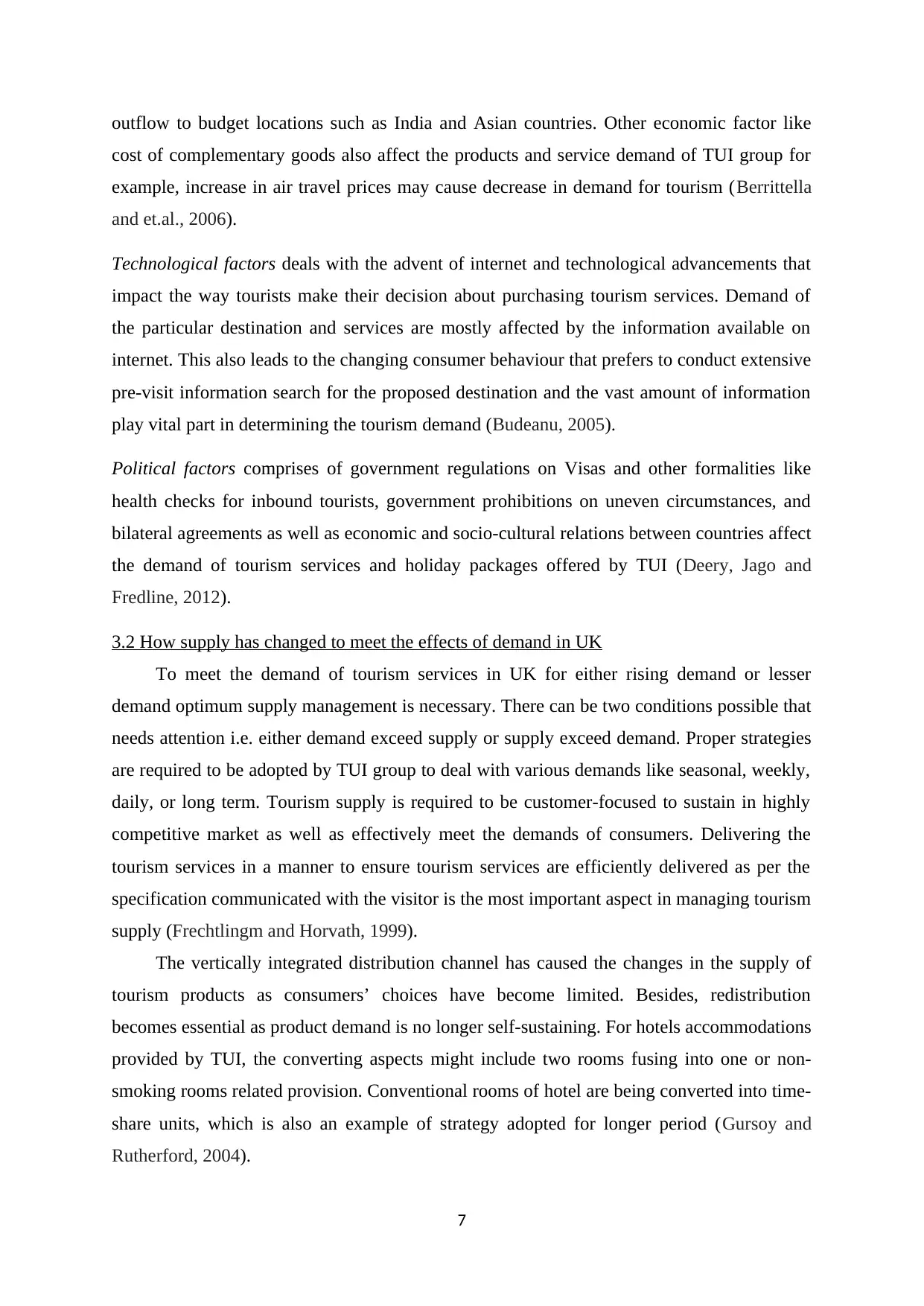
outflow to budget locations such as India and Asian countries. Other economic factor like
cost of complementary goods also affect the products and service demand of TUI group for
example, increase in air travel prices may cause decrease in demand for tourism (Berrittella
and et.al., 2006).
Technological factors deals with the advent of internet and technological advancements that
impact the way tourists make their decision about purchasing tourism services. Demand of
the particular destination and services are mostly affected by the information available on
internet. This also leads to the changing consumer behaviour that prefers to conduct extensive
pre-visit information search for the proposed destination and the vast amount of information
play vital part in determining the tourism demand (Budeanu, 2005).
Political factors comprises of government regulations on Visas and other formalities like
health checks for inbound tourists, government prohibitions on uneven circumstances, and
bilateral agreements as well as economic and socio-cultural relations between countries affect
the demand of tourism services and holiday packages offered by TUI (Deery, Jago and
Fredline, 2012).
3.2 How supply has changed to meet the effects of demand in UK
To meet the demand of tourism services in UK for either rising demand or lesser
demand optimum supply management is necessary. There can be two conditions possible that
needs attention i.e. either demand exceed supply or supply exceed demand. Proper strategies
are required to be adopted by TUI group to deal with various demands like seasonal, weekly,
daily, or long term. Tourism supply is required to be customer-focused to sustain in highly
competitive market as well as effectively meet the demands of consumers. Delivering the
tourism services in a manner to ensure tourism services are efficiently delivered as per the
specification communicated with the visitor is the most important aspect in managing tourism
supply (Frechtlingm and Horvath, 1999).
The vertically integrated distribution channel has caused the changes in the supply of
tourism products as consumers’ choices have become limited. Besides, redistribution
becomes essential as product demand is no longer self-sustaining. For hotels accommodations
provided by TUI, the converting aspects might include two rooms fusing into one or non-
smoking rooms related provision. Conventional rooms of hotel are being converted into time-
share units, which is also an example of strategy adopted for longer period (Gursoy and
Rutherford, 2004).
7
cost of complementary goods also affect the products and service demand of TUI group for
example, increase in air travel prices may cause decrease in demand for tourism (Berrittella
and et.al., 2006).
Technological factors deals with the advent of internet and technological advancements that
impact the way tourists make their decision about purchasing tourism services. Demand of
the particular destination and services are mostly affected by the information available on
internet. This also leads to the changing consumer behaviour that prefers to conduct extensive
pre-visit information search for the proposed destination and the vast amount of information
play vital part in determining the tourism demand (Budeanu, 2005).
Political factors comprises of government regulations on Visas and other formalities like
health checks for inbound tourists, government prohibitions on uneven circumstances, and
bilateral agreements as well as economic and socio-cultural relations between countries affect
the demand of tourism services and holiday packages offered by TUI (Deery, Jago and
Fredline, 2012).
3.2 How supply has changed to meet the effects of demand in UK
To meet the demand of tourism services in UK for either rising demand or lesser
demand optimum supply management is necessary. There can be two conditions possible that
needs attention i.e. either demand exceed supply or supply exceed demand. Proper strategies
are required to be adopted by TUI group to deal with various demands like seasonal, weekly,
daily, or long term. Tourism supply is required to be customer-focused to sustain in highly
competitive market as well as effectively meet the demands of consumers. Delivering the
tourism services in a manner to ensure tourism services are efficiently delivered as per the
specification communicated with the visitor is the most important aspect in managing tourism
supply (Frechtlingm and Horvath, 1999).
The vertically integrated distribution channel has caused the changes in the supply of
tourism products as consumers’ choices have become limited. Besides, redistribution
becomes essential as product demand is no longer self-sustaining. For hotels accommodations
provided by TUI, the converting aspects might include two rooms fusing into one or non-
smoking rooms related provision. Conventional rooms of hotel are being converted into time-
share units, which is also an example of strategy adopted for longer period (Gursoy and
Rutherford, 2004).
7
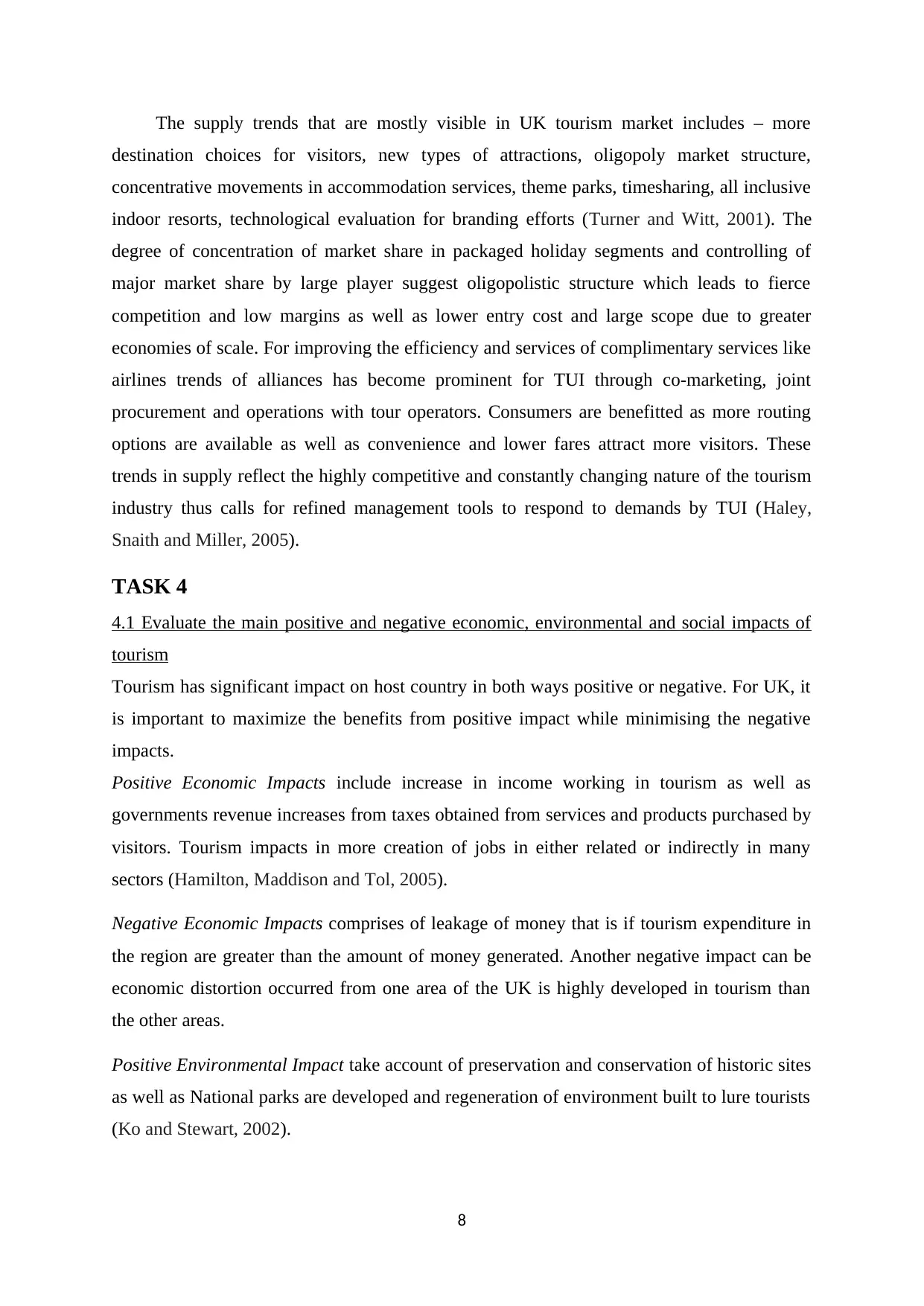
The supply trends that are mostly visible in UK tourism market includes – more
destination choices for visitors, new types of attractions, oligopoly market structure,
concentrative movements in accommodation services, theme parks, timesharing, all inclusive
indoor resorts, technological evaluation for branding efforts (Turner and Witt, 2001). The
degree of concentration of market share in packaged holiday segments and controlling of
major market share by large player suggest oligopolistic structure which leads to fierce
competition and low margins as well as lower entry cost and large scope due to greater
economies of scale. For improving the efficiency and services of complimentary services like
airlines trends of alliances has become prominent for TUI through co-marketing, joint
procurement and operations with tour operators. Consumers are benefitted as more routing
options are available as well as convenience and lower fares attract more visitors. These
trends in supply reflect the highly competitive and constantly changing nature of the tourism
industry thus calls for refined management tools to respond to demands by TUI (Haley,
Snaith and Miller, 2005).
TASK 4
4.1 Evaluate the main positive and negative economic, environmental and social impacts of
tourism
Tourism has significant impact on host country in both ways positive or negative. For UK, it
is important to maximize the benefits from positive impact while minimising the negative
impacts.
Positive Economic Impacts include increase in income working in tourism as well as
governments revenue increases from taxes obtained from services and products purchased by
visitors. Tourism impacts in more creation of jobs in either related or indirectly in many
sectors (Hamilton, Maddison and Tol, 2005).
Negative Economic Impacts comprises of leakage of money that is if tourism expenditure in
the region are greater than the amount of money generated. Another negative impact can be
economic distortion occurred from one area of the UK is highly developed in tourism than
the other areas.
Positive Environmental Impact take account of preservation and conservation of historic sites
as well as National parks are developed and regeneration of environment built to lure tourists
(Ko and Stewart, 2002).
8
destination choices for visitors, new types of attractions, oligopoly market structure,
concentrative movements in accommodation services, theme parks, timesharing, all inclusive
indoor resorts, technological evaluation for branding efforts (Turner and Witt, 2001). The
degree of concentration of market share in packaged holiday segments and controlling of
major market share by large player suggest oligopolistic structure which leads to fierce
competition and low margins as well as lower entry cost and large scope due to greater
economies of scale. For improving the efficiency and services of complimentary services like
airlines trends of alliances has become prominent for TUI through co-marketing, joint
procurement and operations with tour operators. Consumers are benefitted as more routing
options are available as well as convenience and lower fares attract more visitors. These
trends in supply reflect the highly competitive and constantly changing nature of the tourism
industry thus calls for refined management tools to respond to demands by TUI (Haley,
Snaith and Miller, 2005).
TASK 4
4.1 Evaluate the main positive and negative economic, environmental and social impacts of
tourism
Tourism has significant impact on host country in both ways positive or negative. For UK, it
is important to maximize the benefits from positive impact while minimising the negative
impacts.
Positive Economic Impacts include increase in income working in tourism as well as
governments revenue increases from taxes obtained from services and products purchased by
visitors. Tourism impacts in more creation of jobs in either related or indirectly in many
sectors (Hamilton, Maddison and Tol, 2005).
Negative Economic Impacts comprises of leakage of money that is if tourism expenditure in
the region are greater than the amount of money generated. Another negative impact can be
economic distortion occurred from one area of the UK is highly developed in tourism than
the other areas.
Positive Environmental Impact take account of preservation and conservation of historic sites
as well as National parks are developed and regeneration of environment built to lure tourists
(Ko and Stewart, 2002).
8
Secure Best Marks with AI Grader
Need help grading? Try our AI Grader for instant feedback on your assignments.
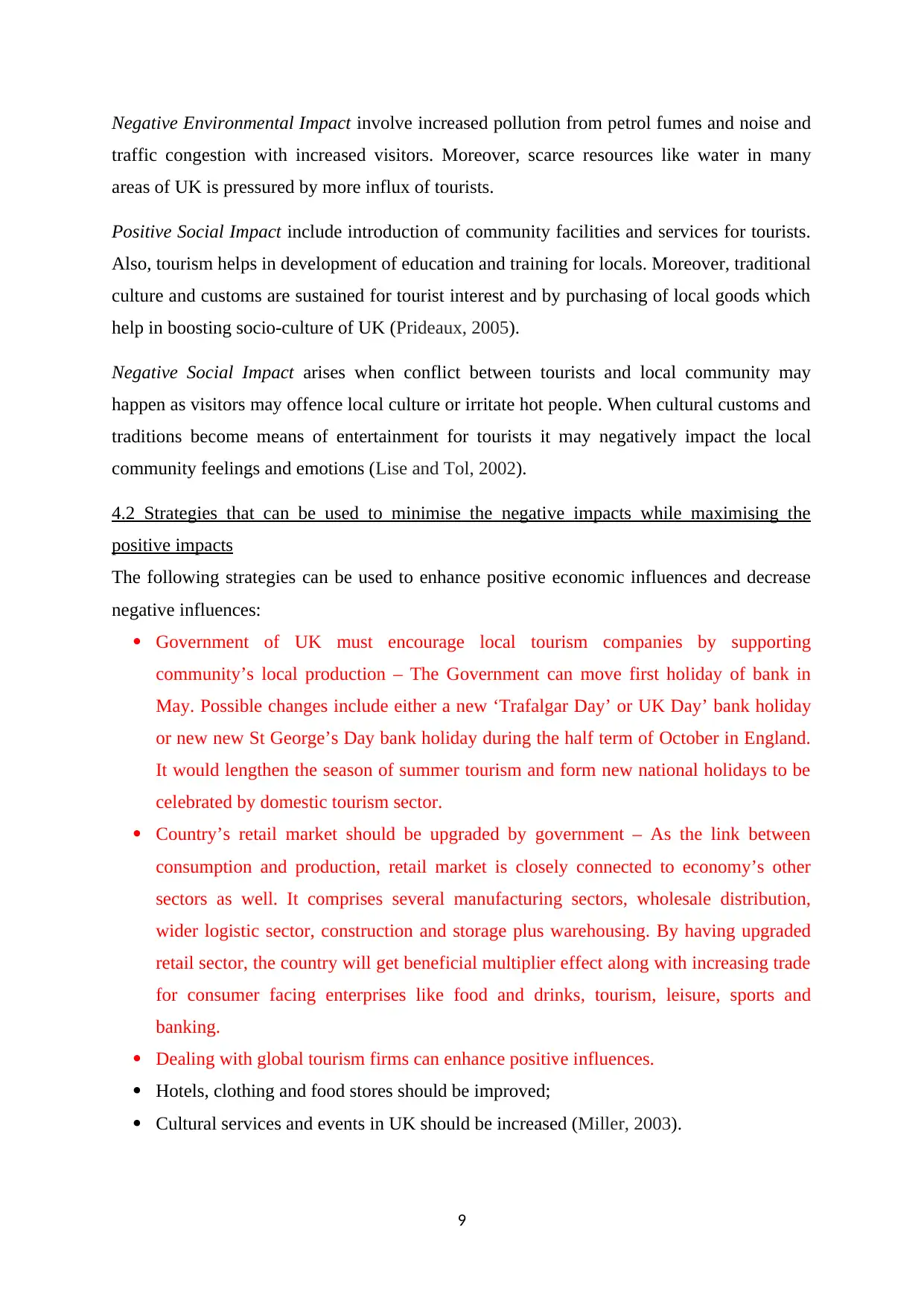
Negative Environmental Impact involve increased pollution from petrol fumes and noise and
traffic congestion with increased visitors. Moreover, scarce resources like water in many
areas of UK is pressured by more influx of tourists.
Positive Social Impact include introduction of community facilities and services for tourists.
Also, tourism helps in development of education and training for locals. Moreover, traditional
culture and customs are sustained for tourist interest and by purchasing of local goods which
help in boosting socio-culture of UK (Prideaux, 2005).
Negative Social Impact arises when conflict between tourists and local community may
happen as visitors may offence local culture or irritate hot people. When cultural customs and
traditions become means of entertainment for tourists it may negatively impact the local
community feelings and emotions (Lise and Tol, 2002).
4.2 Strategies that can be used to minimise the negative impacts while maximising the
positive impacts
The following strategies can be used to enhance positive economic influences and decrease
negative influences:
Government of UK must encourage local tourism companies by supporting
community’s local production – The Government can move first holiday of bank in
May. Possible changes include either a new ‘Trafalgar Day’ or UK Day’ bank holiday
or new new St George’s Day bank holiday during the half term of October in England.
It would lengthen the season of summer tourism and form new national holidays to be
celebrated by domestic tourism sector.
Country’s retail market should be upgraded by government – As the link between
consumption and production, retail market is closely connected to economy’s other
sectors as well. It comprises several manufacturing sectors, wholesale distribution,
wider logistic sector, construction and storage plus warehousing. By having upgraded
retail sector, the country will get beneficial multiplier effect along with increasing trade
for consumer facing enterprises like food and drinks, tourism, leisure, sports and
banking.
Dealing with global tourism firms can enhance positive influences.
Hotels, clothing and food stores should be improved;
Cultural services and events in UK should be increased (Miller, 2003).
9
traffic congestion with increased visitors. Moreover, scarce resources like water in many
areas of UK is pressured by more influx of tourists.
Positive Social Impact include introduction of community facilities and services for tourists.
Also, tourism helps in development of education and training for locals. Moreover, traditional
culture and customs are sustained for tourist interest and by purchasing of local goods which
help in boosting socio-culture of UK (Prideaux, 2005).
Negative Social Impact arises when conflict between tourists and local community may
happen as visitors may offence local culture or irritate hot people. When cultural customs and
traditions become means of entertainment for tourists it may negatively impact the local
community feelings and emotions (Lise and Tol, 2002).
4.2 Strategies that can be used to minimise the negative impacts while maximising the
positive impacts
The following strategies can be used to enhance positive economic influences and decrease
negative influences:
Government of UK must encourage local tourism companies by supporting
community’s local production – The Government can move first holiday of bank in
May. Possible changes include either a new ‘Trafalgar Day’ or UK Day’ bank holiday
or new new St George’s Day bank holiday during the half term of October in England.
It would lengthen the season of summer tourism and form new national holidays to be
celebrated by domestic tourism sector.
Country’s retail market should be upgraded by government – As the link between
consumption and production, retail market is closely connected to economy’s other
sectors as well. It comprises several manufacturing sectors, wholesale distribution,
wider logistic sector, construction and storage plus warehousing. By having upgraded
retail sector, the country will get beneficial multiplier effect along with increasing trade
for consumer facing enterprises like food and drinks, tourism, leisure, sports and
banking.
Dealing with global tourism firms can enhance positive influences.
Hotels, clothing and food stores should be improved;
Cultural services and events in UK should be increased (Miller, 2003).
9
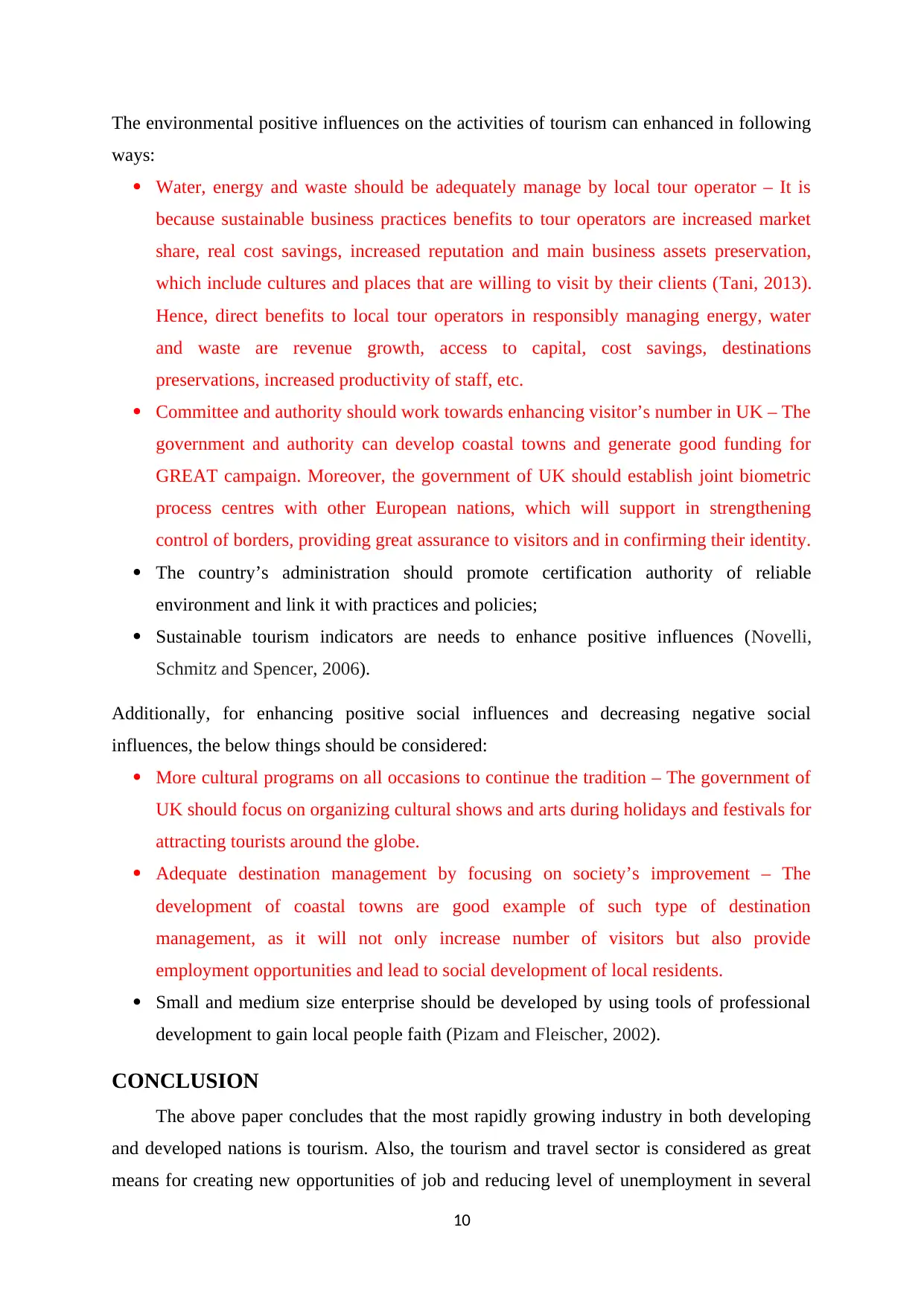
The environmental positive influences on the activities of tourism can enhanced in following
ways:
Water, energy and waste should be adequately manage by local tour operator – It is
because sustainable business practices benefits to tour operators are increased market
share, real cost savings, increased reputation and main business assets preservation,
which include cultures and places that are willing to visit by their clients (Tani, 2013).
Hence, direct benefits to local tour operators in responsibly managing energy, water
and waste are revenue growth, access to capital, cost savings, destinations
preservations, increased productivity of staff, etc.
Committee and authority should work towards enhancing visitor’s number in UK – The
government and authority can develop coastal towns and generate good funding for
GREAT campaign. Moreover, the government of UK should establish joint biometric
process centres with other European nations, which will support in strengthening
control of borders, providing great assurance to visitors and in confirming their identity.
The country’s administration should promote certification authority of reliable
environment and link it with practices and policies;
Sustainable tourism indicators are needs to enhance positive influences (Novelli,
Schmitz and Spencer, 2006).
Additionally, for enhancing positive social influences and decreasing negative social
influences, the below things should be considered:
More cultural programs on all occasions to continue the tradition – The government of
UK should focus on organizing cultural shows and arts during holidays and festivals for
attracting tourists around the globe.
Adequate destination management by focusing on society’s improvement – The
development of coastal towns are good example of such type of destination
management, as it will not only increase number of visitors but also provide
employment opportunities and lead to social development of local residents.
Small and medium size enterprise should be developed by using tools of professional
development to gain local people faith (Pizam and Fleischer, 2002).
CONCLUSION
The above paper concludes that the most rapidly growing industry in both developing
and developed nations is tourism. Also, the tourism and travel sector is considered as great
means for creating new opportunities of job and reducing level of unemployment in several
10
ways:
Water, energy and waste should be adequately manage by local tour operator – It is
because sustainable business practices benefits to tour operators are increased market
share, real cost savings, increased reputation and main business assets preservation,
which include cultures and places that are willing to visit by their clients (Tani, 2013).
Hence, direct benefits to local tour operators in responsibly managing energy, water
and waste are revenue growth, access to capital, cost savings, destinations
preservations, increased productivity of staff, etc.
Committee and authority should work towards enhancing visitor’s number in UK – The
government and authority can develop coastal towns and generate good funding for
GREAT campaign. Moreover, the government of UK should establish joint biometric
process centres with other European nations, which will support in strengthening
control of borders, providing great assurance to visitors and in confirming their identity.
The country’s administration should promote certification authority of reliable
environment and link it with practices and policies;
Sustainable tourism indicators are needs to enhance positive influences (Novelli,
Schmitz and Spencer, 2006).
Additionally, for enhancing positive social influences and decreasing negative social
influences, the below things should be considered:
More cultural programs on all occasions to continue the tradition – The government of
UK should focus on organizing cultural shows and arts during holidays and festivals for
attracting tourists around the globe.
Adequate destination management by focusing on society’s improvement – The
development of coastal towns are good example of such type of destination
management, as it will not only increase number of visitors but also provide
employment opportunities and lead to social development of local residents.
Small and medium size enterprise should be developed by using tools of professional
development to gain local people faith (Pizam and Fleischer, 2002).
CONCLUSION
The above paper concludes that the most rapidly growing industry in both developing
and developed nations is tourism. Also, the tourism and travel sector is considered as great
means for creating new opportunities of job and reducing level of unemployment in several
10
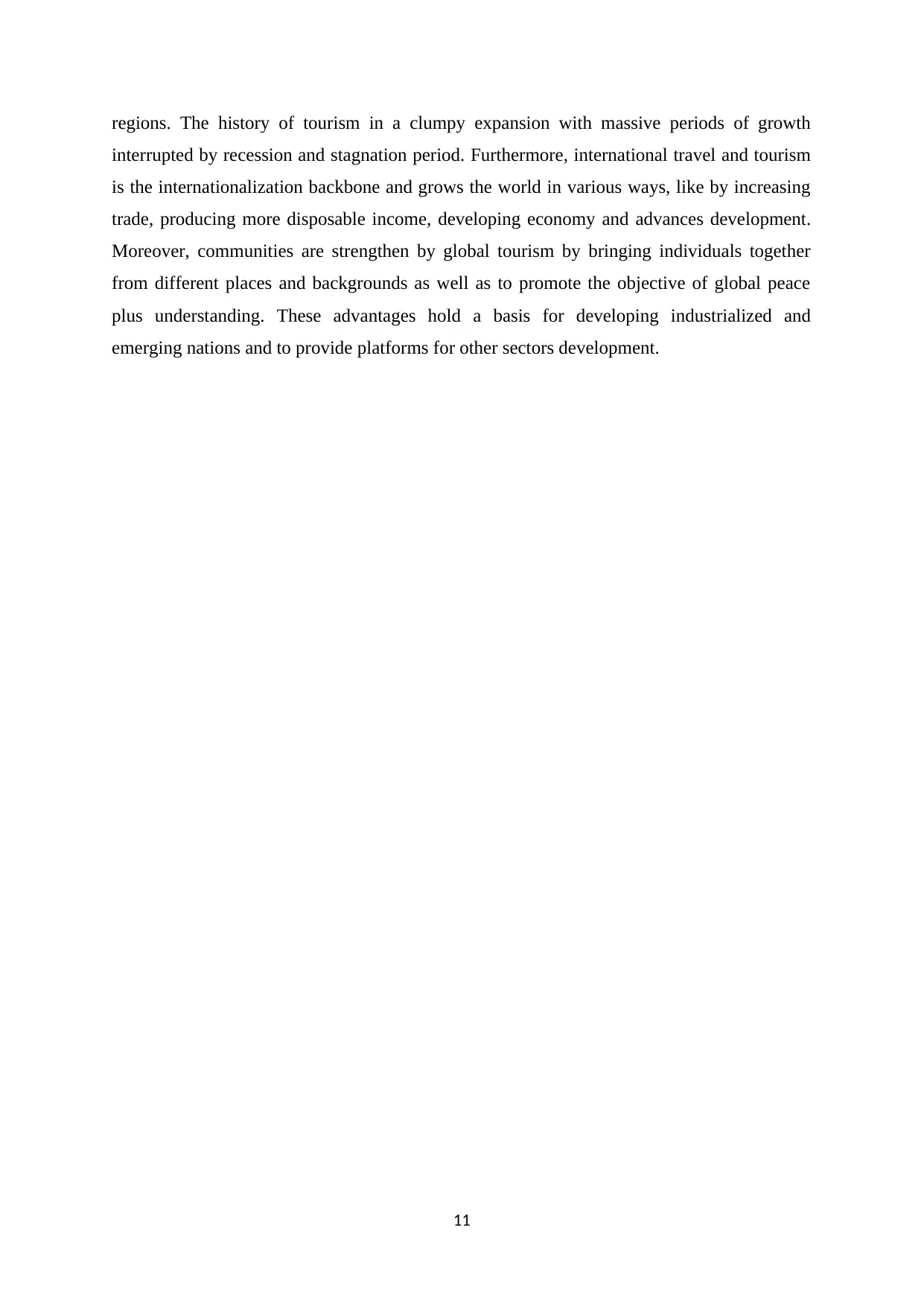
regions. The history of tourism in a clumpy expansion with massive periods of growth
interrupted by recession and stagnation period. Furthermore, international travel and tourism
is the internationalization backbone and grows the world in various ways, like by increasing
trade, producing more disposable income, developing economy and advances development.
Moreover, communities are strengthen by global tourism by bringing individuals together
from different places and backgrounds as well as to promote the objective of global peace
plus understanding. These advantages hold a basis for developing industrialized and
emerging nations and to provide platforms for other sectors development.
11
interrupted by recession and stagnation period. Furthermore, international travel and tourism
is the internationalization backbone and grows the world in various ways, like by increasing
trade, producing more disposable income, developing economy and advances development.
Moreover, communities are strengthen by global tourism by bringing individuals together
from different places and backgrounds as well as to promote the objective of global peace
plus understanding. These advantages hold a basis for developing industrialized and
emerging nations and to provide platforms for other sectors development.
11
Paraphrase This Document
Need a fresh take? Get an instant paraphrase of this document with our AI Paraphraser
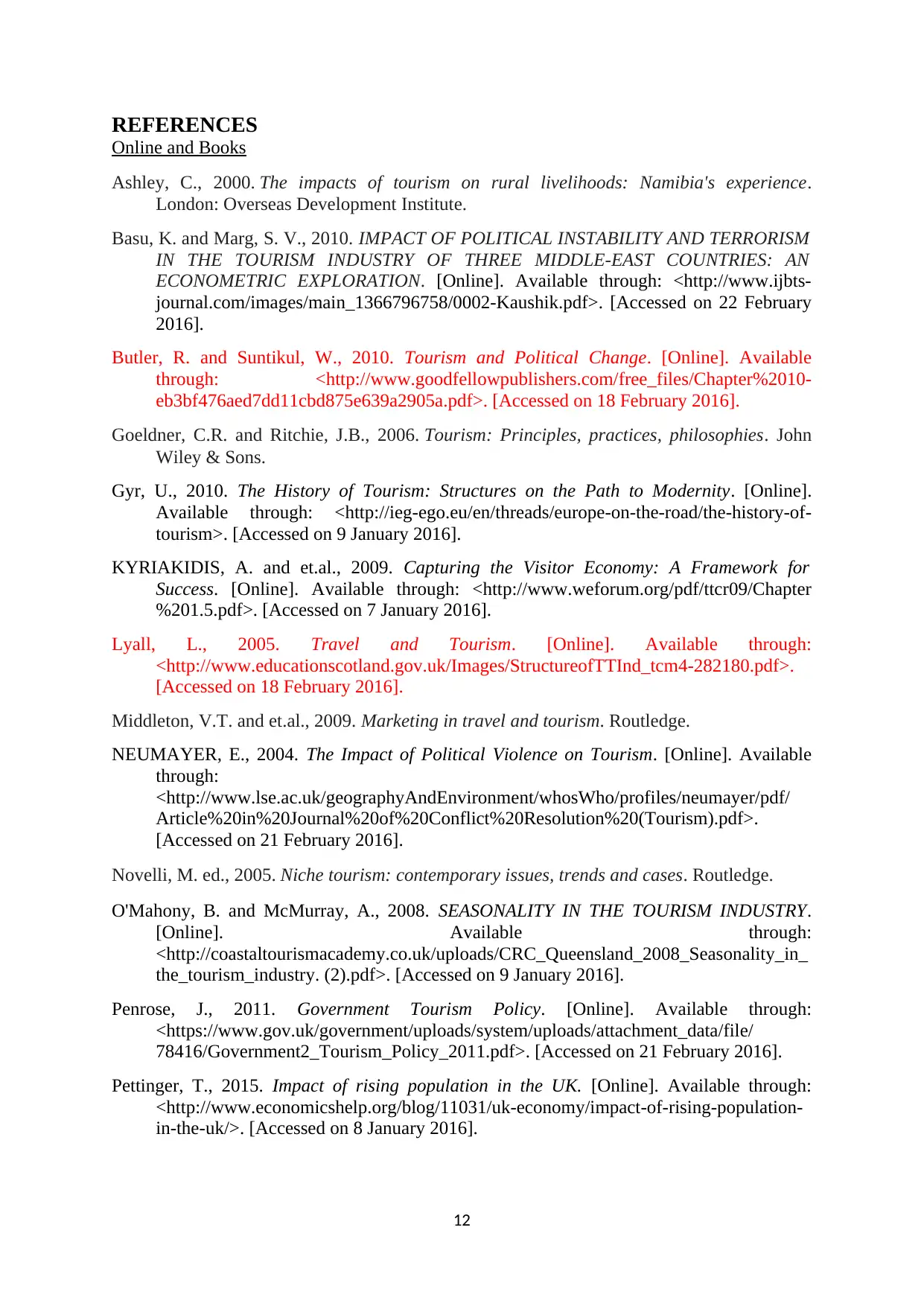
REFERENCES
Online and Books
Ashley, C., 2000. The impacts of tourism on rural livelihoods: Namibia's experience.
London: Overseas Development Institute.
Basu, K. and Marg, S. V., 2010. IMPACT OF POLITICAL INSTABILITY AND TERRORISM
IN THE TOURISM INDUSTRY OF THREE MIDDLE-EAST COUNTRIES: AN
ECONOMETRIC EXPLORATION. [Online]. Available through: <http://www.ijbts-
journal.com/images/main_1366796758/0002-Kaushik.pdf>. [Accessed on 22 February
2016].
Butler, R. and Suntikul, W., 2010. Tourism and Political Change. [Online]. Available
through: <http://www.goodfellowpublishers.com/free_files/Chapter%2010-
eb3bf476aed7dd11cbd875e639a2905a.pdf>. [Accessed on 18 February 2016].
Goeldner, C.R. and Ritchie, J.B., 2006. Tourism: Principles, practices, philosophies. John
Wiley & Sons.
Gyr, U., 2010. The History of Tourism: Structures on the Path to Modernity. [Online].
Available through: <http://ieg-ego.eu/en/threads/europe-on-the-road/the-history-of-
tourism>. [Accessed on 9 January 2016].
KYRIAKIDIS, A. and et.al., 2009. Capturing the Visitor Economy: A Framework for
Success. [Online]. Available through: <http://www.weforum.org/pdf/ttcr09/Chapter
%201.5.pdf>. [Accessed on 7 January 2016].
Lyall, L., 2005. Travel and Tourism. [Online]. Available through:
<http://www.educationscotland.gov.uk/Images/StructureofTTInd_tcm4-282180.pdf>.
[Accessed on 18 February 2016].
Middleton, V.T. and et.al., 2009. Marketing in travel and tourism. Routledge.
NEUMAYER, E., 2004. The Impact of Political Violence on Tourism. [Online]. Available
through:
<http://www.lse.ac.uk/geographyAndEnvironment/whosWho/profiles/neumayer/pdf/
Article%20in%20Journal%20of%20Conflict%20Resolution%20(Tourism).pdf>.
[Accessed on 21 February 2016].
Novelli, M. ed., 2005. Niche tourism: contemporary issues, trends and cases. Routledge.
O'Mahony, B. and McMurray, A., 2008. SEASONALITY IN THE TOURISM INDUSTRY.
[Online]. Available through:
<http://coastaltourismacademy.co.uk/uploads/CRC_Queensland_2008_Seasonality_in_
the_tourism_industry. (2).pdf>. [Accessed on 9 January 2016].
Penrose, J., 2011. Government Tourism Policy. [Online]. Available through:
<https://www.gov.uk/government/uploads/system/uploads/attachment_data/file/
78416/Government2_Tourism_Policy_2011.pdf>. [Accessed on 21 February 2016].
Pettinger, T., 2015. Impact of rising population in the UK. [Online]. Available through:
<http://www.economicshelp.org/blog/11031/uk-economy/impact-of-rising-population-
in-the-uk/>. [Accessed on 8 January 2016].
12
Online and Books
Ashley, C., 2000. The impacts of tourism on rural livelihoods: Namibia's experience.
London: Overseas Development Institute.
Basu, K. and Marg, S. V., 2010. IMPACT OF POLITICAL INSTABILITY AND TERRORISM
IN THE TOURISM INDUSTRY OF THREE MIDDLE-EAST COUNTRIES: AN
ECONOMETRIC EXPLORATION. [Online]. Available through: <http://www.ijbts-
journal.com/images/main_1366796758/0002-Kaushik.pdf>. [Accessed on 22 February
2016].
Butler, R. and Suntikul, W., 2010. Tourism and Political Change. [Online]. Available
through: <http://www.goodfellowpublishers.com/free_files/Chapter%2010-
eb3bf476aed7dd11cbd875e639a2905a.pdf>. [Accessed on 18 February 2016].
Goeldner, C.R. and Ritchie, J.B., 2006. Tourism: Principles, practices, philosophies. John
Wiley & Sons.
Gyr, U., 2010. The History of Tourism: Structures on the Path to Modernity. [Online].
Available through: <http://ieg-ego.eu/en/threads/europe-on-the-road/the-history-of-
tourism>. [Accessed on 9 January 2016].
KYRIAKIDIS, A. and et.al., 2009. Capturing the Visitor Economy: A Framework for
Success. [Online]. Available through: <http://www.weforum.org/pdf/ttcr09/Chapter
%201.5.pdf>. [Accessed on 7 January 2016].
Lyall, L., 2005. Travel and Tourism. [Online]. Available through:
<http://www.educationscotland.gov.uk/Images/StructureofTTInd_tcm4-282180.pdf>.
[Accessed on 18 February 2016].
Middleton, V.T. and et.al., 2009. Marketing in travel and tourism. Routledge.
NEUMAYER, E., 2004. The Impact of Political Violence on Tourism. [Online]. Available
through:
<http://www.lse.ac.uk/geographyAndEnvironment/whosWho/profiles/neumayer/pdf/
Article%20in%20Journal%20of%20Conflict%20Resolution%20(Tourism).pdf>.
[Accessed on 21 February 2016].
Novelli, M. ed., 2005. Niche tourism: contemporary issues, trends and cases. Routledge.
O'Mahony, B. and McMurray, A., 2008. SEASONALITY IN THE TOURISM INDUSTRY.
[Online]. Available through:
<http://coastaltourismacademy.co.uk/uploads/CRC_Queensland_2008_Seasonality_in_
the_tourism_industry. (2).pdf>. [Accessed on 9 January 2016].
Penrose, J., 2011. Government Tourism Policy. [Online]. Available through:
<https://www.gov.uk/government/uploads/system/uploads/attachment_data/file/
78416/Government2_Tourism_Policy_2011.pdf>. [Accessed on 21 February 2016].
Pettinger, T., 2015. Impact of rising population in the UK. [Online]. Available through:
<http://www.economicshelp.org/blog/11031/uk-economy/impact-of-rising-population-
in-the-uk/>. [Accessed on 8 January 2016].
12
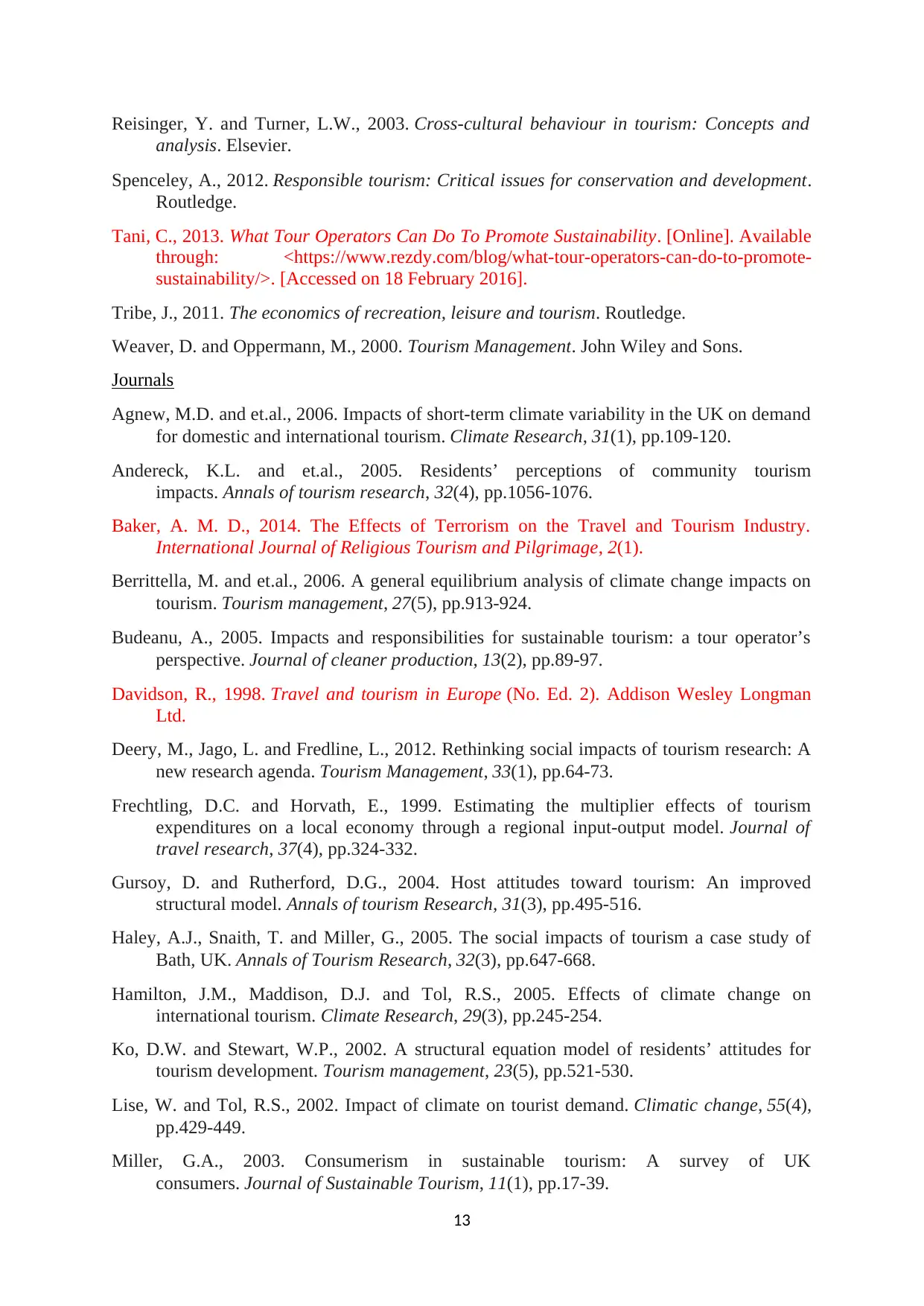
Reisinger, Y. and Turner, L.W., 2003. Cross-cultural behaviour in tourism: Concepts and
analysis. Elsevier.
Spenceley, A., 2012. Responsible tourism: Critical issues for conservation and development.
Routledge.
Tani, C., 2013. What Tour Operators Can Do To Promote Sustainability. [Online]. Available
through: <https://www.rezdy.com/blog/what-tour-operators-can-do-to-promote-
sustainability/>. [Accessed on 18 February 2016].
Tribe, J., 2011. The economics of recreation, leisure and tourism. Routledge.
Weaver, D. and Oppermann, M., 2000. Tourism Management. John Wiley and Sons.
Journals
Agnew, M.D. and et.al., 2006. Impacts of short-term climate variability in the UK on demand
for domestic and international tourism. Climate Research, 31(1), pp.109-120.
Andereck, K.L. and et.al., 2005. Residents’ perceptions of community tourism
impacts. Annals of tourism research, 32(4), pp.1056-1076.
Baker, A. M. D., 2014. The Effects of Terrorism on the Travel and Tourism Industry.
International Journal of Religious Tourism and Pilgrimage, 2(1).
Berrittella, M. and et.al., 2006. A general equilibrium analysis of climate change impacts on
tourism. Tourism management, 27(5), pp.913-924.
Budeanu, A., 2005. Impacts and responsibilities for sustainable tourism: a tour operator’s
perspective. Journal of cleaner production, 13(2), pp.89-97.
Davidson, R., 1998. Travel and tourism in Europe (No. Ed. 2). Addison Wesley Longman
Ltd.
Deery, M., Jago, L. and Fredline, L., 2012. Rethinking social impacts of tourism research: A
new research agenda. Tourism Management, 33(1), pp.64-73.
Frechtling, D.C. and Horvath, E., 1999. Estimating the multiplier effects of tourism
expenditures on a local economy through a regional input-output model. Journal of
travel research, 37(4), pp.324-332.
Gursoy, D. and Rutherford, D.G., 2004. Host attitudes toward tourism: An improved
structural model. Annals of tourism Research, 31(3), pp.495-516.
Haley, A.J., Snaith, T. and Miller, G., 2005. The social impacts of tourism a case study of
Bath, UK. Annals of Tourism Research, 32(3), pp.647-668.
Hamilton, J.M., Maddison, D.J. and Tol, R.S., 2005. Effects of climate change on
international tourism. Climate Research, 29(3), pp.245-254.
Ko, D.W. and Stewart, W.P., 2002. A structural equation model of residents’ attitudes for
tourism development. Tourism management, 23(5), pp.521-530.
Lise, W. and Tol, R.S., 2002. Impact of climate on tourist demand. Climatic change, 55(4),
pp.429-449.
Miller, G.A., 2003. Consumerism in sustainable tourism: A survey of UK
consumers. Journal of Sustainable Tourism, 11(1), pp.17-39.
13
analysis. Elsevier.
Spenceley, A., 2012. Responsible tourism: Critical issues for conservation and development.
Routledge.
Tani, C., 2013. What Tour Operators Can Do To Promote Sustainability. [Online]. Available
through: <https://www.rezdy.com/blog/what-tour-operators-can-do-to-promote-
sustainability/>. [Accessed on 18 February 2016].
Tribe, J., 2011. The economics of recreation, leisure and tourism. Routledge.
Weaver, D. and Oppermann, M., 2000. Tourism Management. John Wiley and Sons.
Journals
Agnew, M.D. and et.al., 2006. Impacts of short-term climate variability in the UK on demand
for domestic and international tourism. Climate Research, 31(1), pp.109-120.
Andereck, K.L. and et.al., 2005. Residents’ perceptions of community tourism
impacts. Annals of tourism research, 32(4), pp.1056-1076.
Baker, A. M. D., 2014. The Effects of Terrorism on the Travel and Tourism Industry.
International Journal of Religious Tourism and Pilgrimage, 2(1).
Berrittella, M. and et.al., 2006. A general equilibrium analysis of climate change impacts on
tourism. Tourism management, 27(5), pp.913-924.
Budeanu, A., 2005. Impacts and responsibilities for sustainable tourism: a tour operator’s
perspective. Journal of cleaner production, 13(2), pp.89-97.
Davidson, R., 1998. Travel and tourism in Europe (No. Ed. 2). Addison Wesley Longman
Ltd.
Deery, M., Jago, L. and Fredline, L., 2012. Rethinking social impacts of tourism research: A
new research agenda. Tourism Management, 33(1), pp.64-73.
Frechtling, D.C. and Horvath, E., 1999. Estimating the multiplier effects of tourism
expenditures on a local economy through a regional input-output model. Journal of
travel research, 37(4), pp.324-332.
Gursoy, D. and Rutherford, D.G., 2004. Host attitudes toward tourism: An improved
structural model. Annals of tourism Research, 31(3), pp.495-516.
Haley, A.J., Snaith, T. and Miller, G., 2005. The social impacts of tourism a case study of
Bath, UK. Annals of Tourism Research, 32(3), pp.647-668.
Hamilton, J.M., Maddison, D.J. and Tol, R.S., 2005. Effects of climate change on
international tourism. Climate Research, 29(3), pp.245-254.
Ko, D.W. and Stewart, W.P., 2002. A structural equation model of residents’ attitudes for
tourism development. Tourism management, 23(5), pp.521-530.
Lise, W. and Tol, R.S., 2002. Impact of climate on tourist demand. Climatic change, 55(4),
pp.429-449.
Miller, G.A., 2003. Consumerism in sustainable tourism: A survey of UK
consumers. Journal of Sustainable Tourism, 11(1), pp.17-39.
13
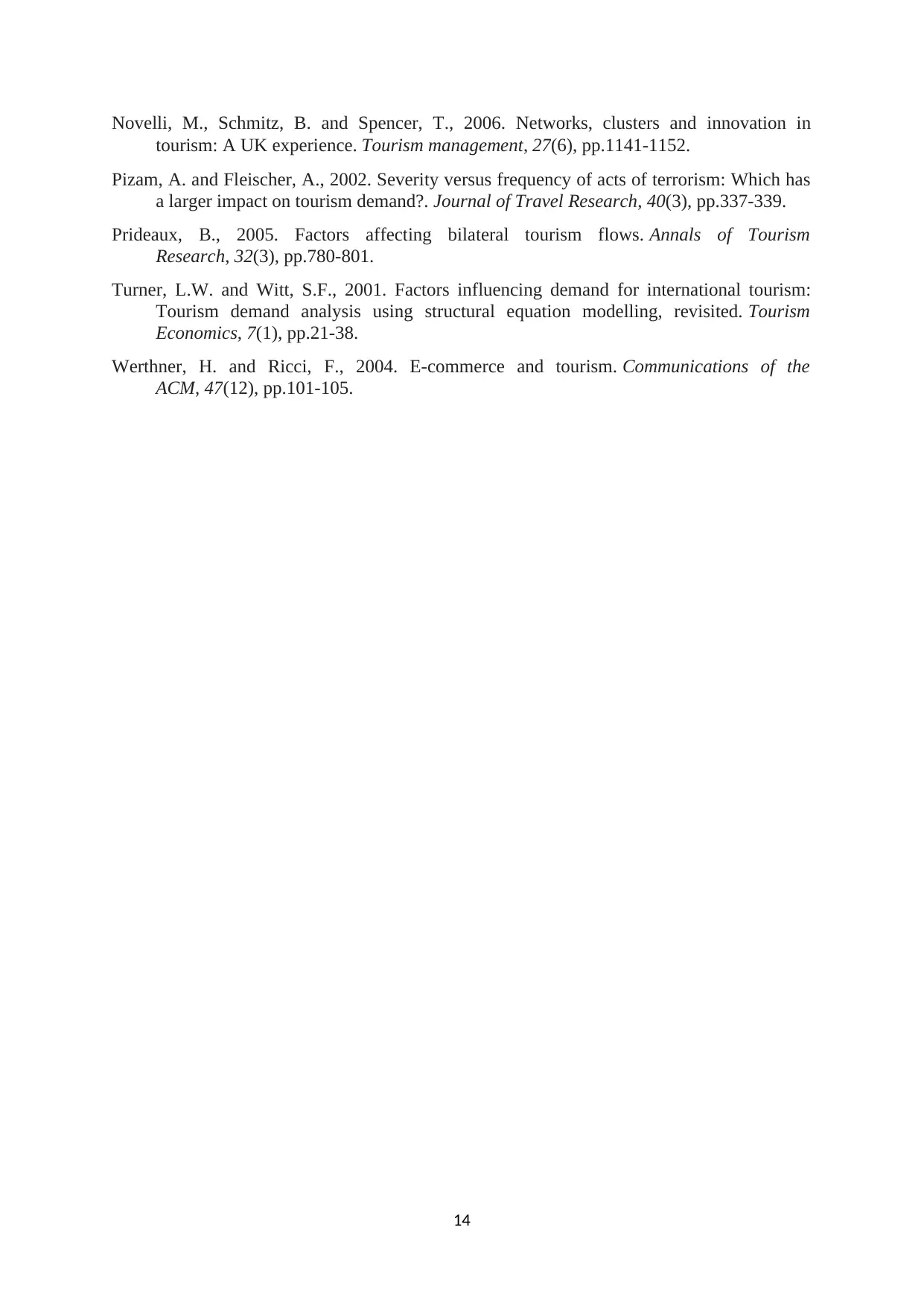
Novelli, M., Schmitz, B. and Spencer, T., 2006. Networks, clusters and innovation in
tourism: A UK experience. Tourism management, 27(6), pp.1141-1152.
Pizam, A. and Fleischer, A., 2002. Severity versus frequency of acts of terrorism: Which has
a larger impact on tourism demand?. Journal of Travel Research, 40(3), pp.337-339.
Prideaux, B., 2005. Factors affecting bilateral tourism flows. Annals of Tourism
Research, 32(3), pp.780-801.
Turner, L.W. and Witt, S.F., 2001. Factors influencing demand for international tourism:
Tourism demand analysis using structural equation modelling, revisited. Tourism
Economics, 7(1), pp.21-38.
Werthner, H. and Ricci, F., 2004. E-commerce and tourism. Communications of the
ACM, 47(12), pp.101-105.
14
tourism: A UK experience. Tourism management, 27(6), pp.1141-1152.
Pizam, A. and Fleischer, A., 2002. Severity versus frequency of acts of terrorism: Which has
a larger impact on tourism demand?. Journal of Travel Research, 40(3), pp.337-339.
Prideaux, B., 2005. Factors affecting bilateral tourism flows. Annals of Tourism
Research, 32(3), pp.780-801.
Turner, L.W. and Witt, S.F., 2001. Factors influencing demand for international tourism:
Tourism demand analysis using structural equation modelling, revisited. Tourism
Economics, 7(1), pp.21-38.
Werthner, H. and Ricci, F., 2004. E-commerce and tourism. Communications of the
ACM, 47(12), pp.101-105.
14
1 out of 16
Related Documents
Your All-in-One AI-Powered Toolkit for Academic Success.
+13062052269
info@desklib.com
Available 24*7 on WhatsApp / Email
![[object Object]](/_next/static/media/star-bottom.7253800d.svg)
Unlock your academic potential
© 2024 | Zucol Services PVT LTD | All rights reserved.





